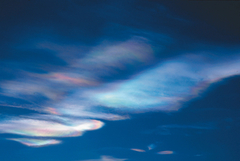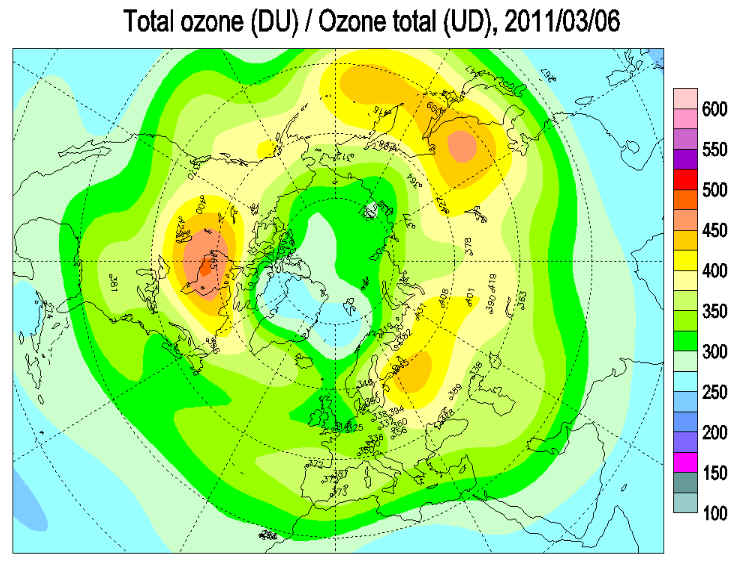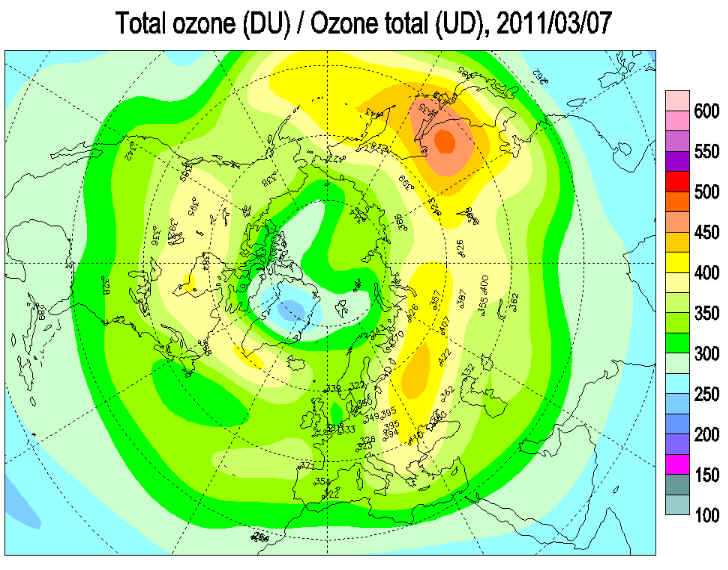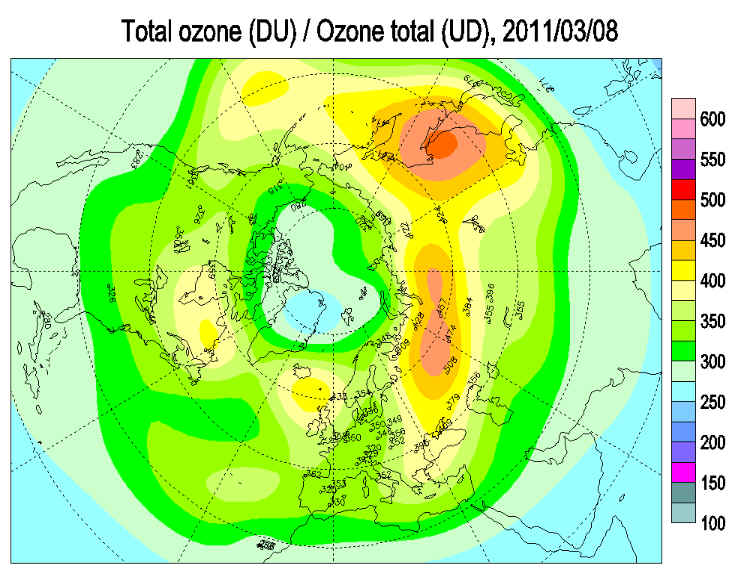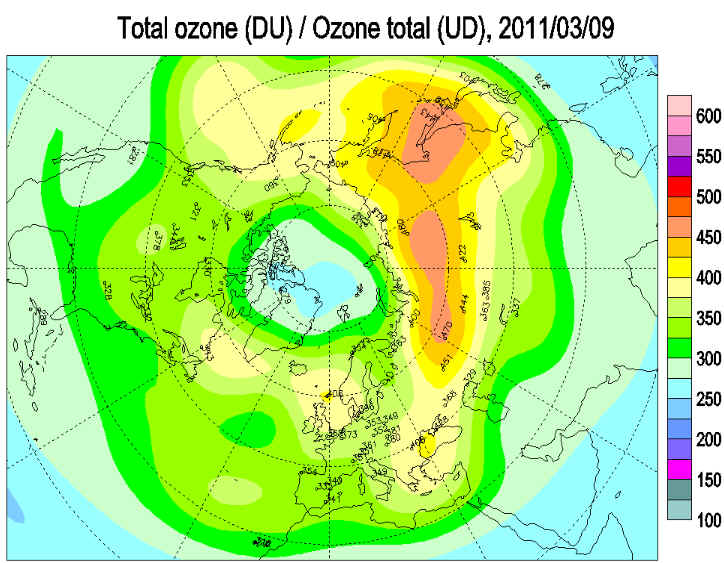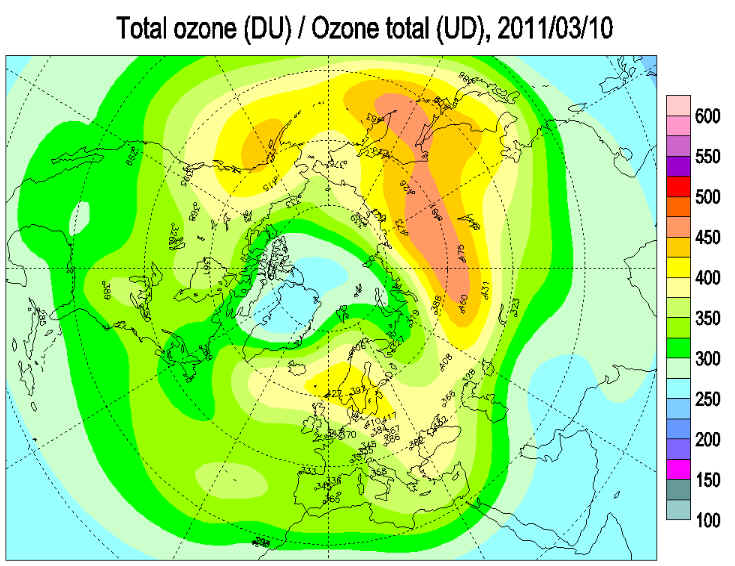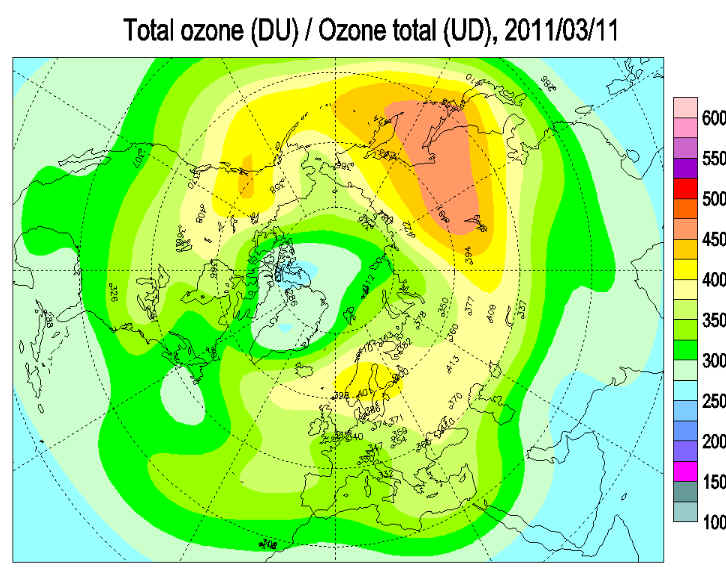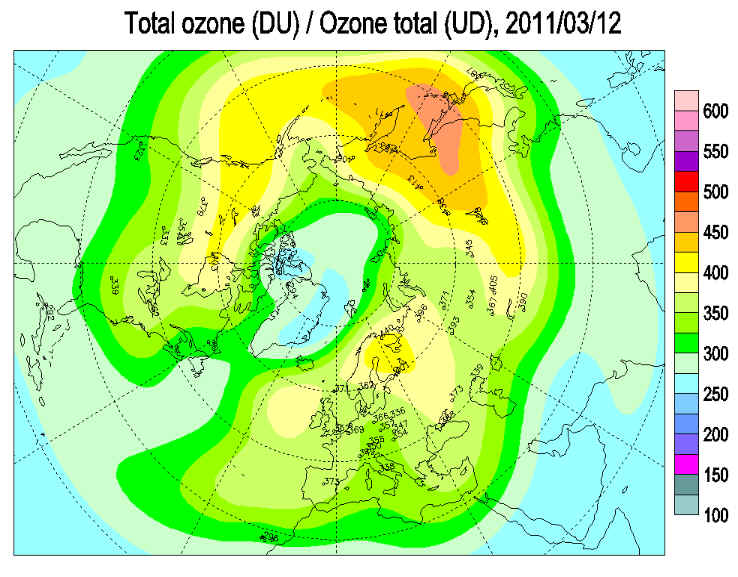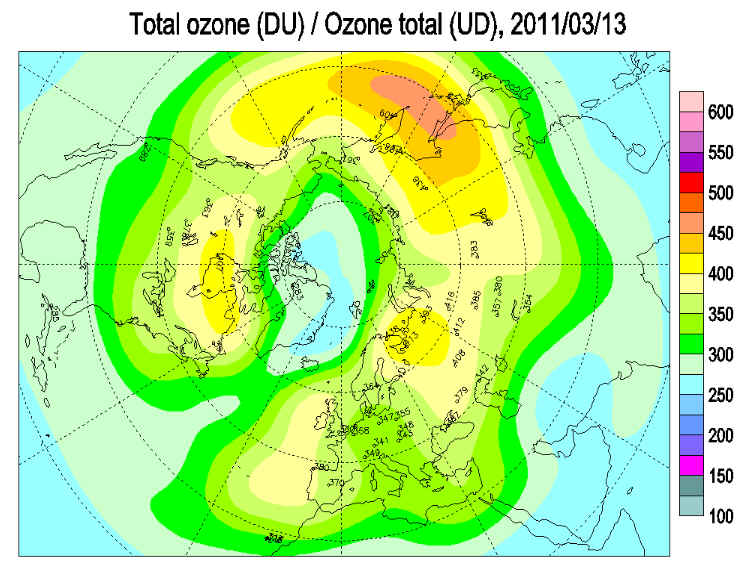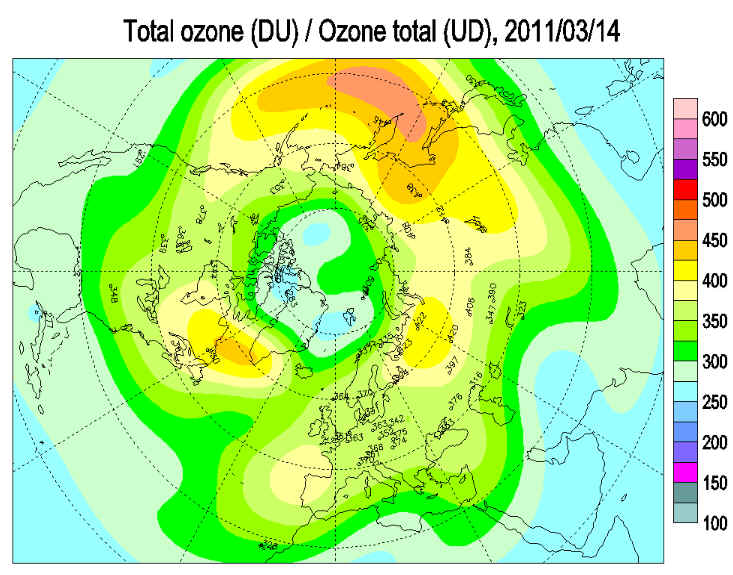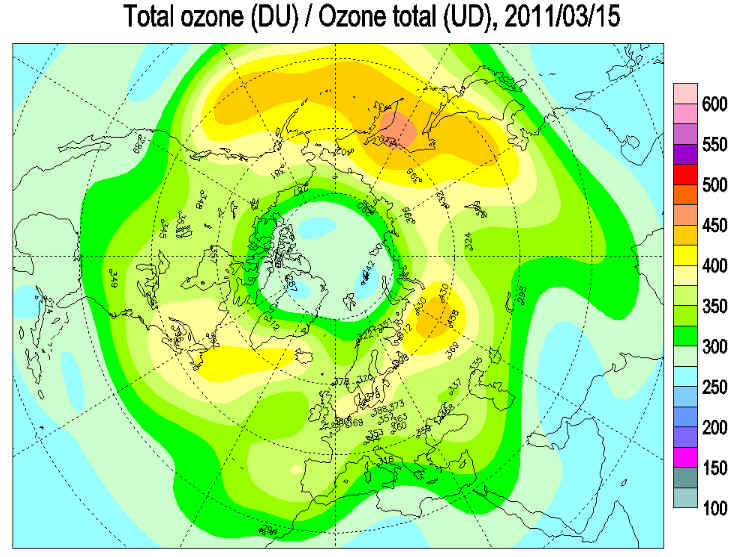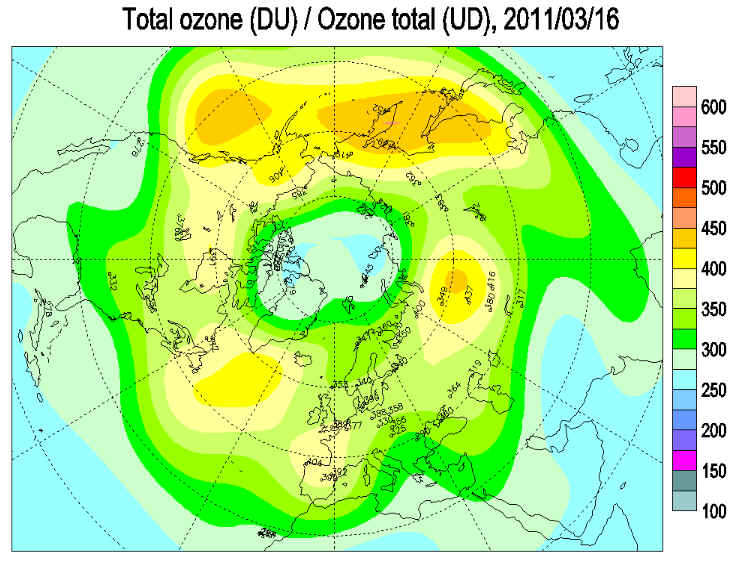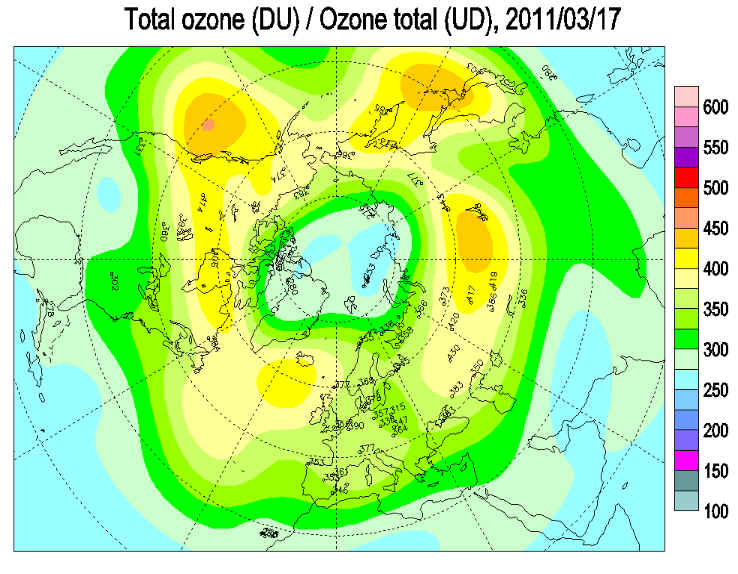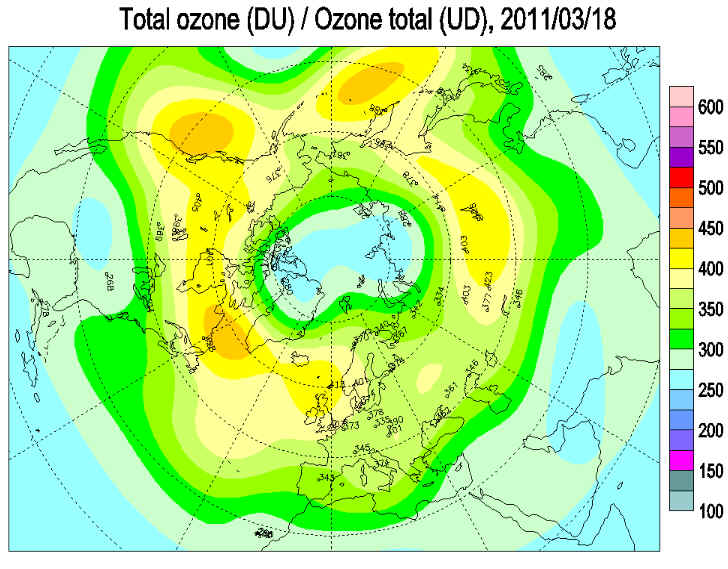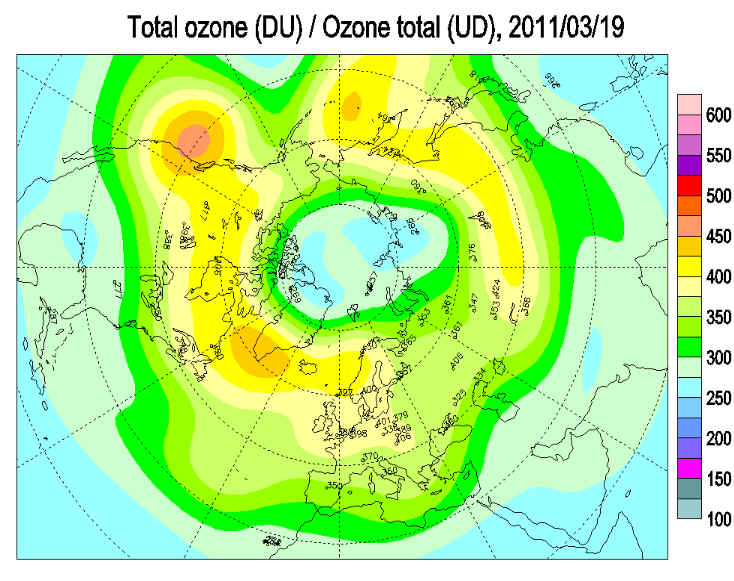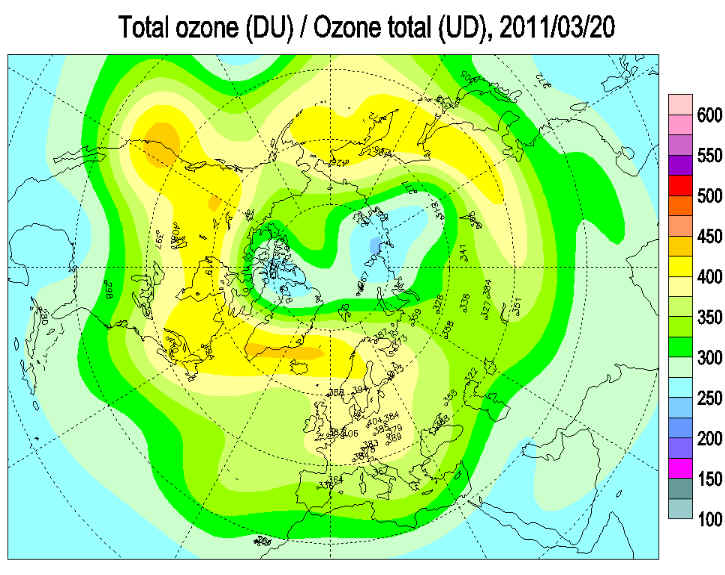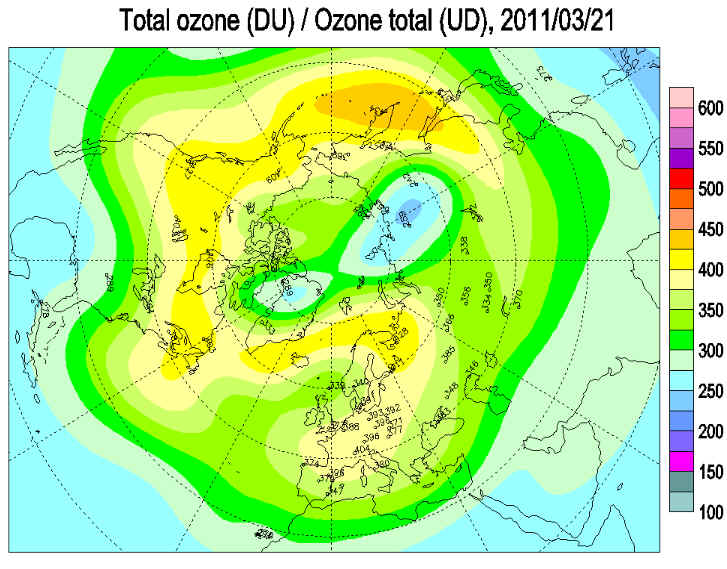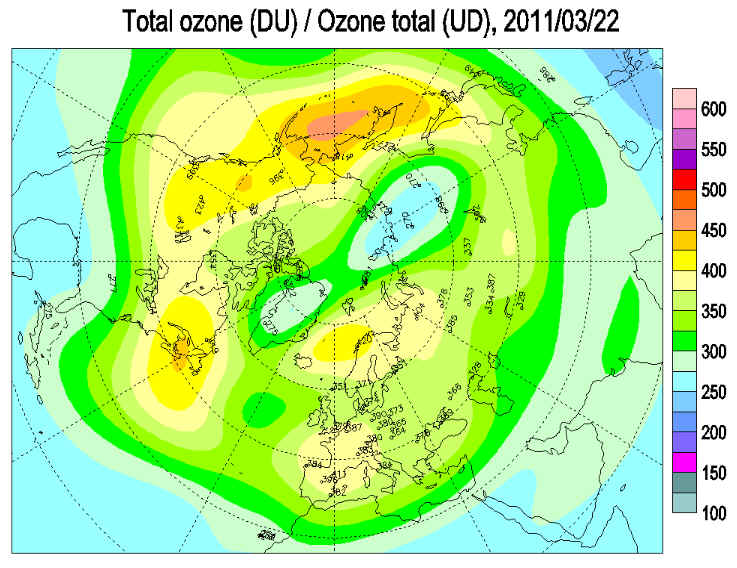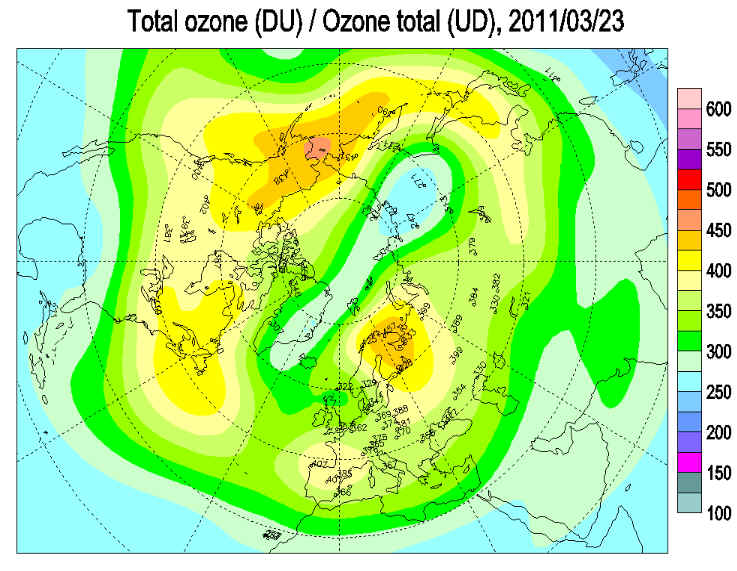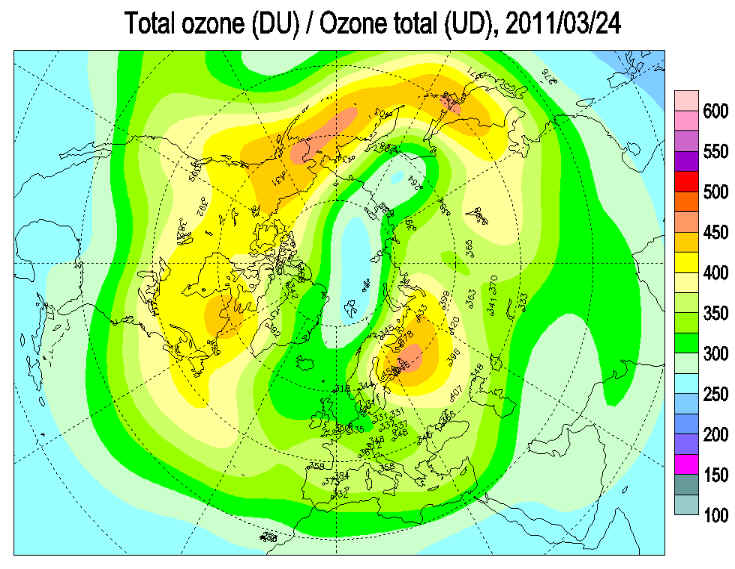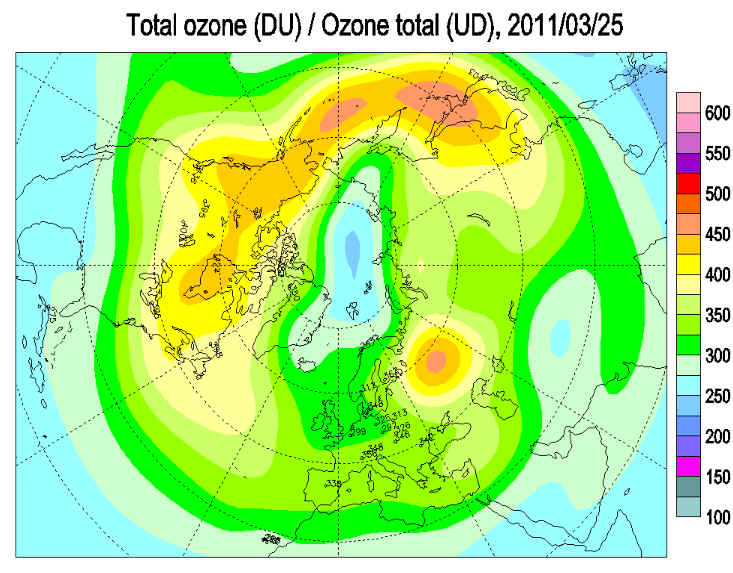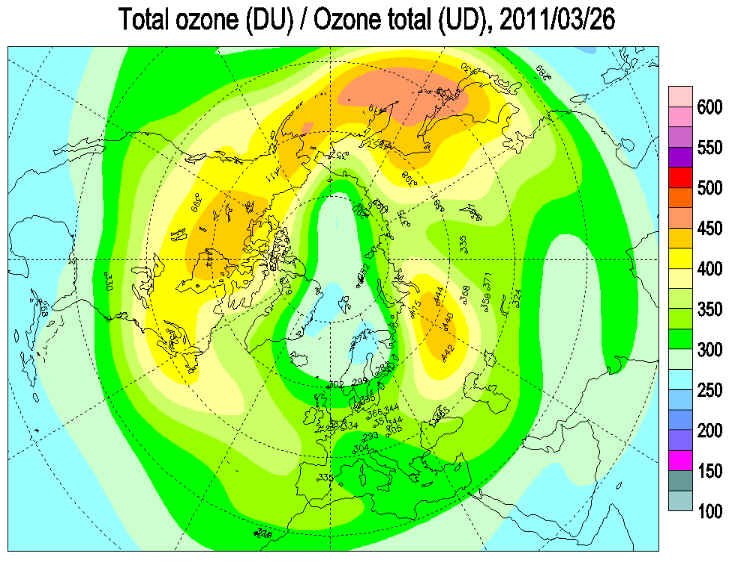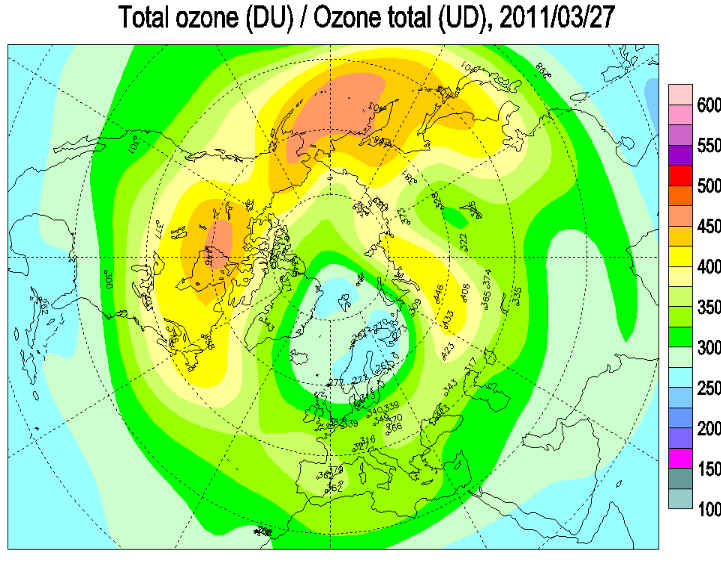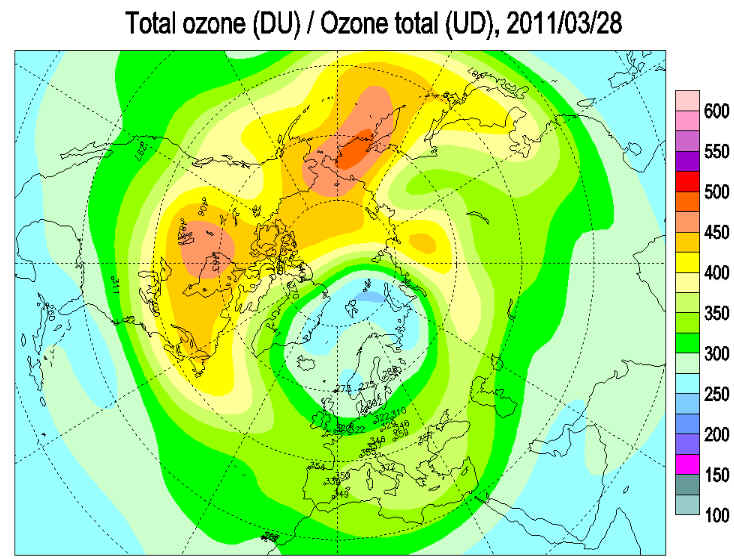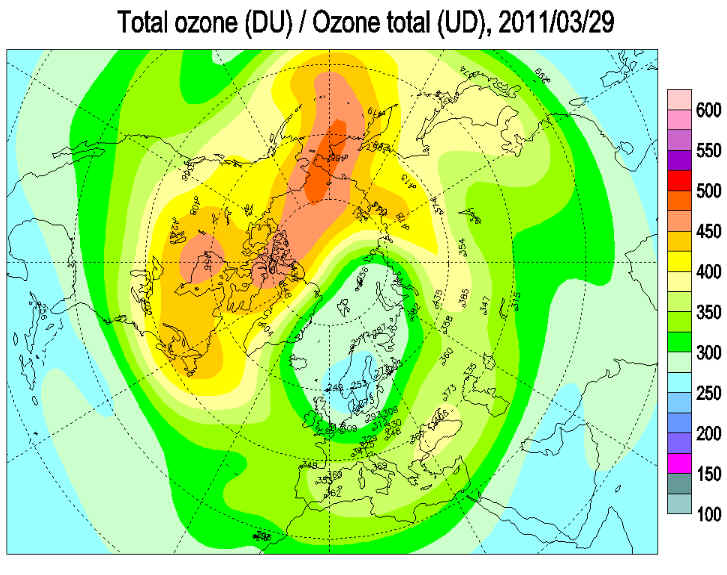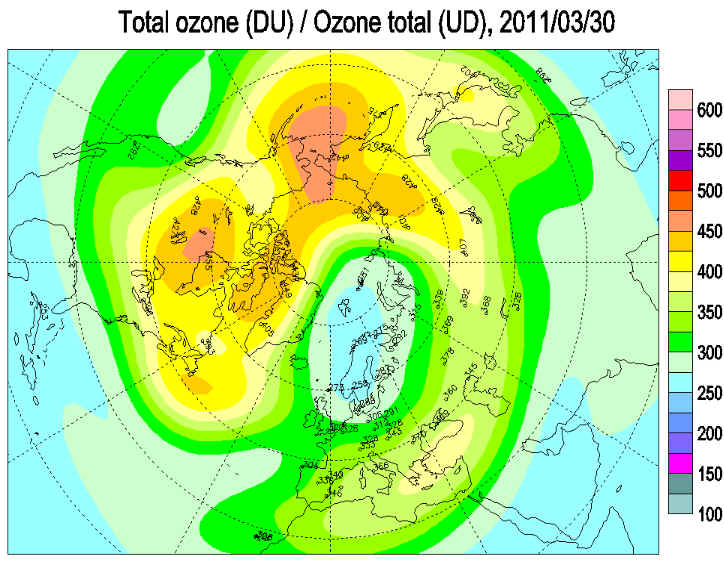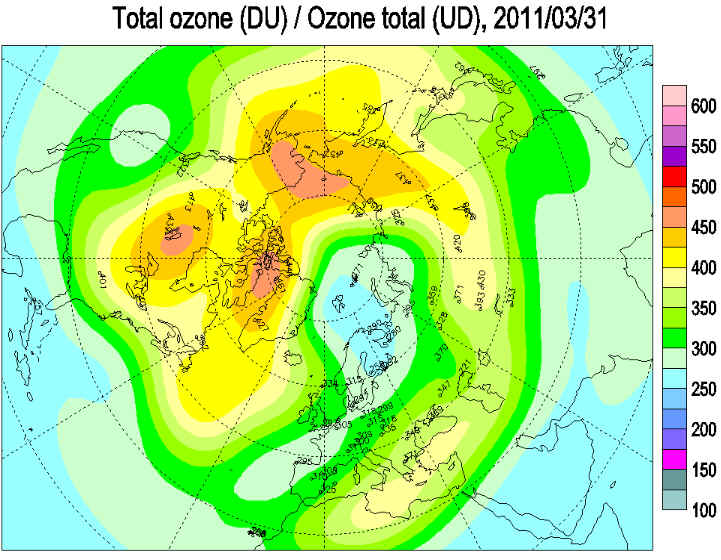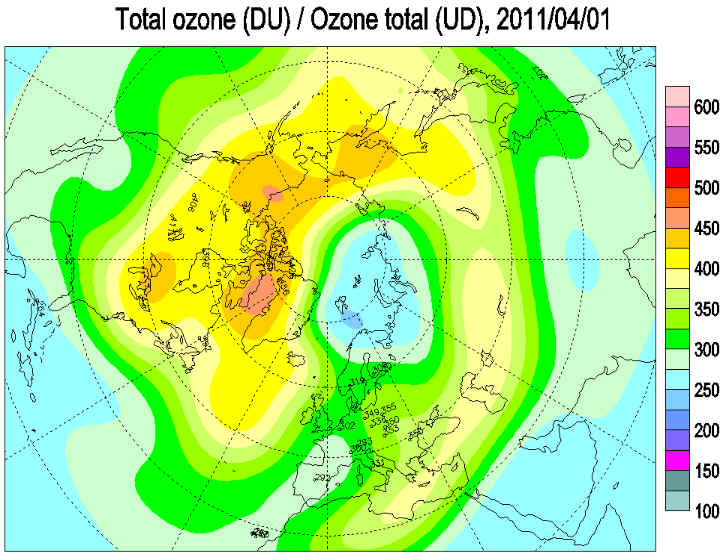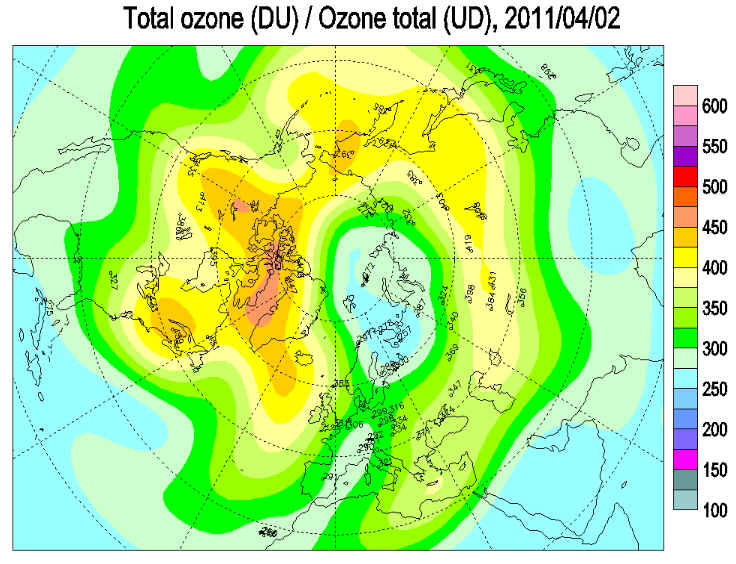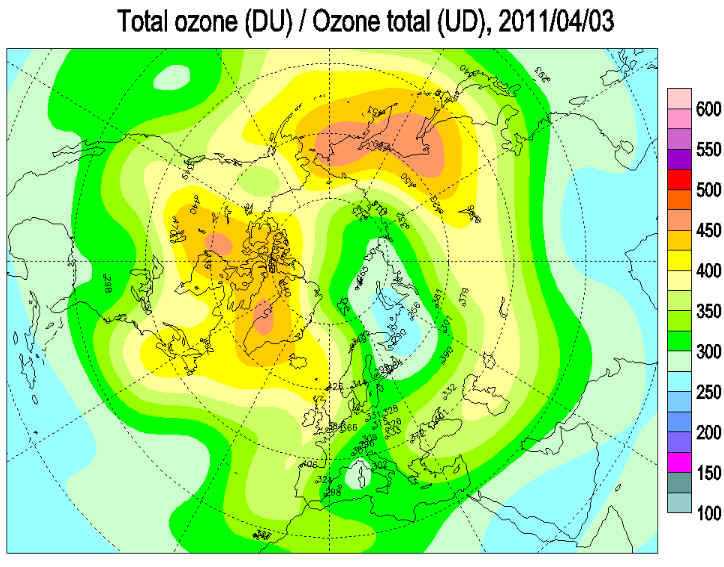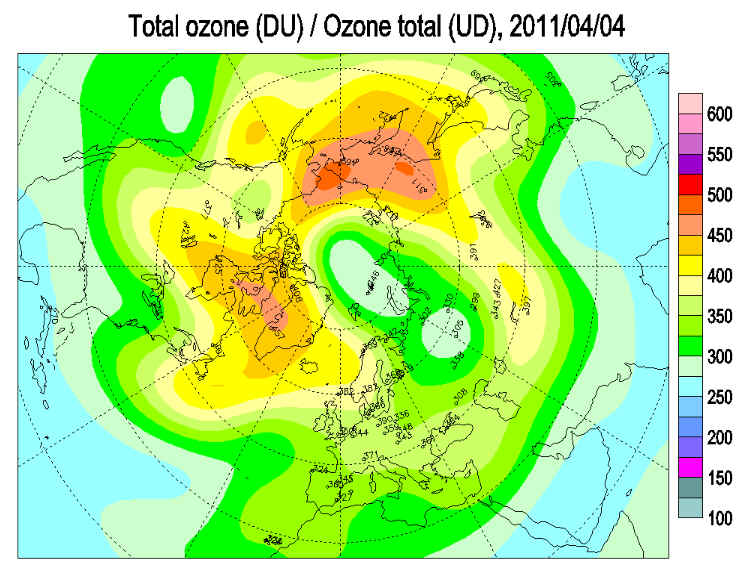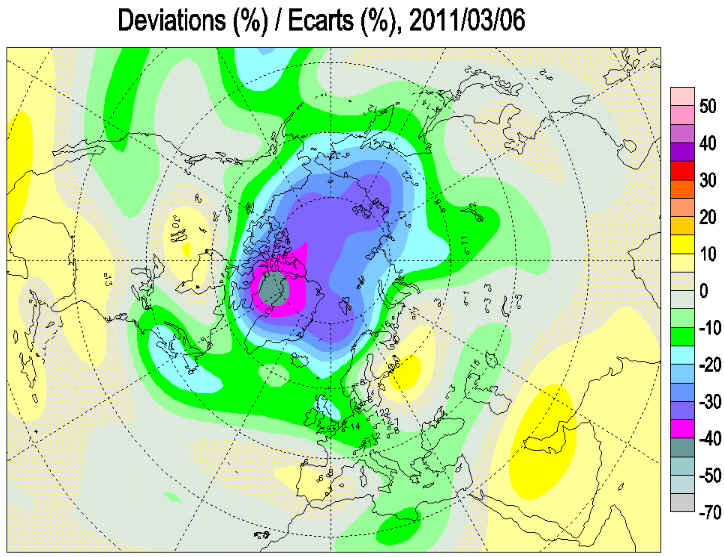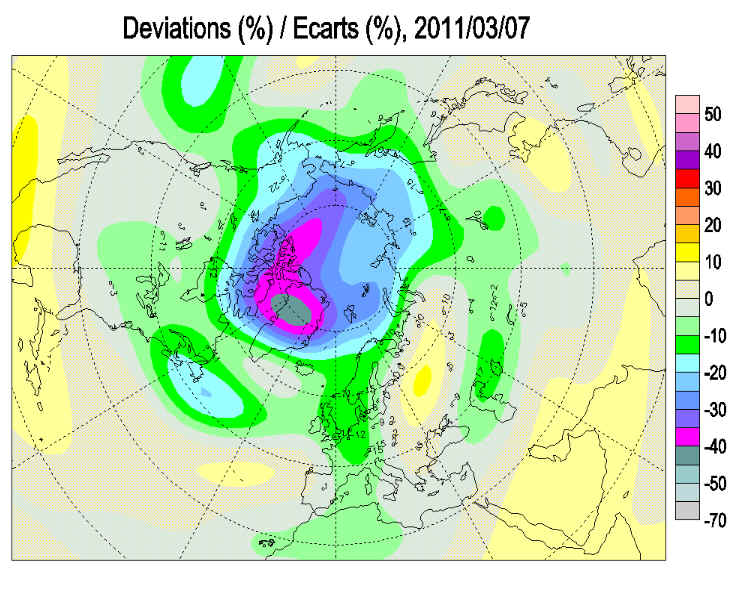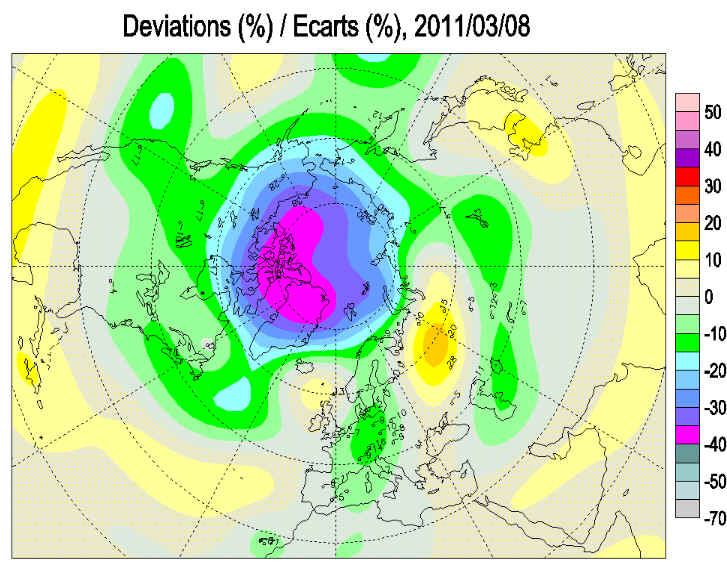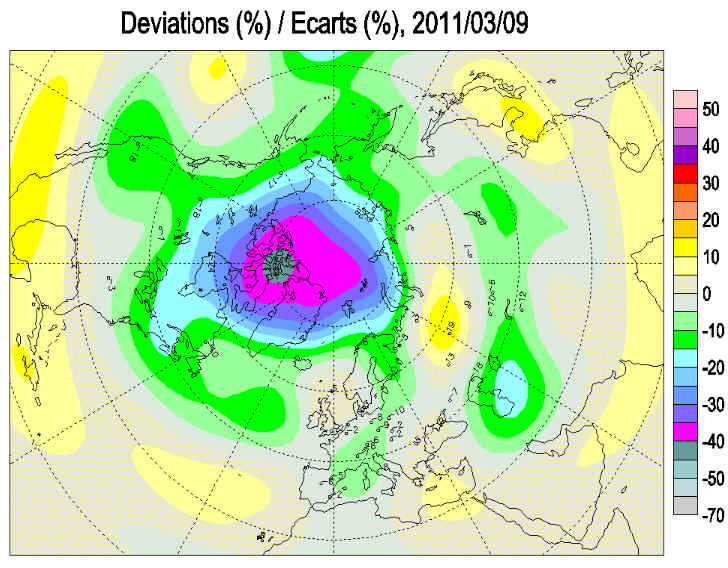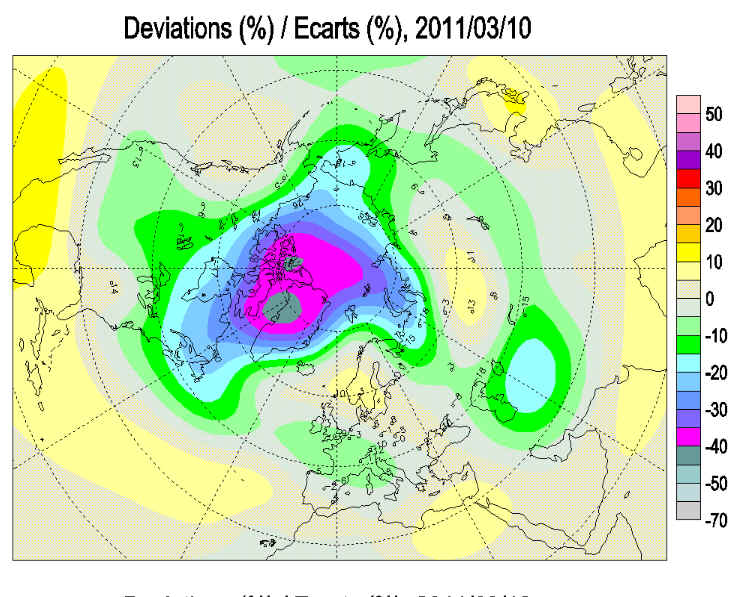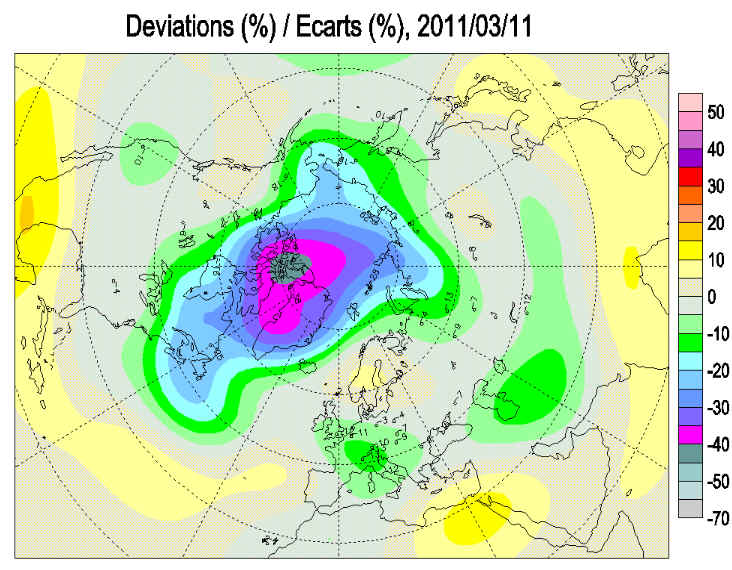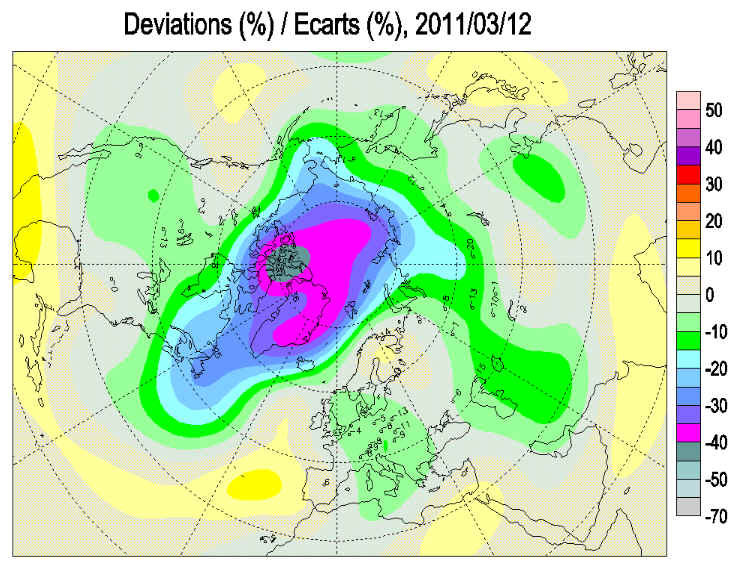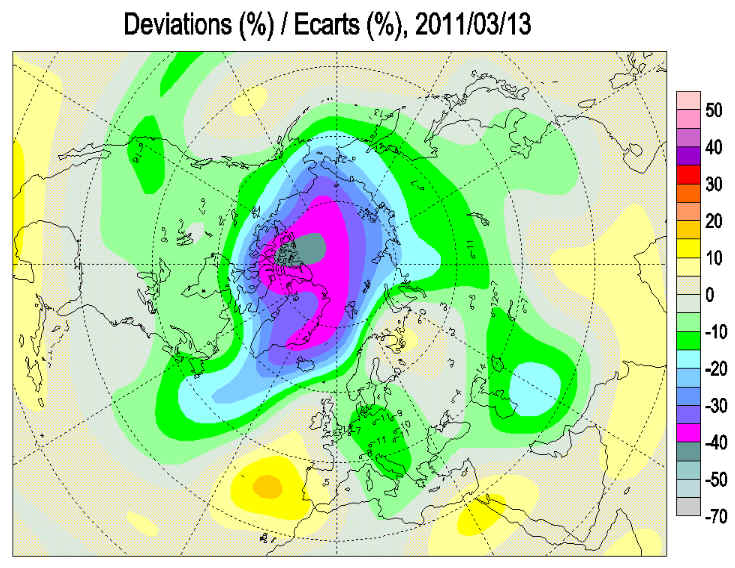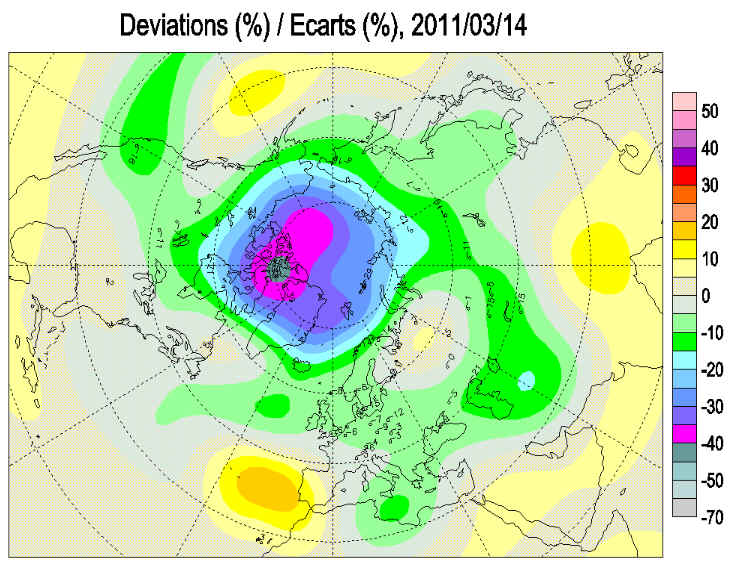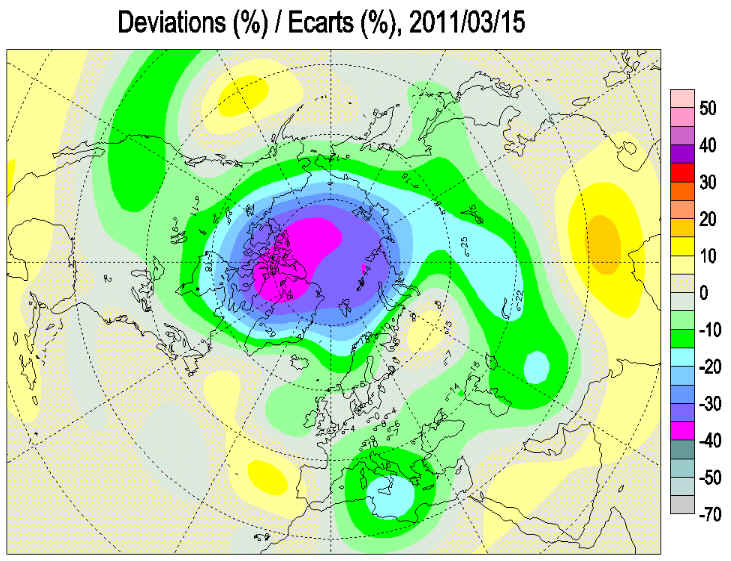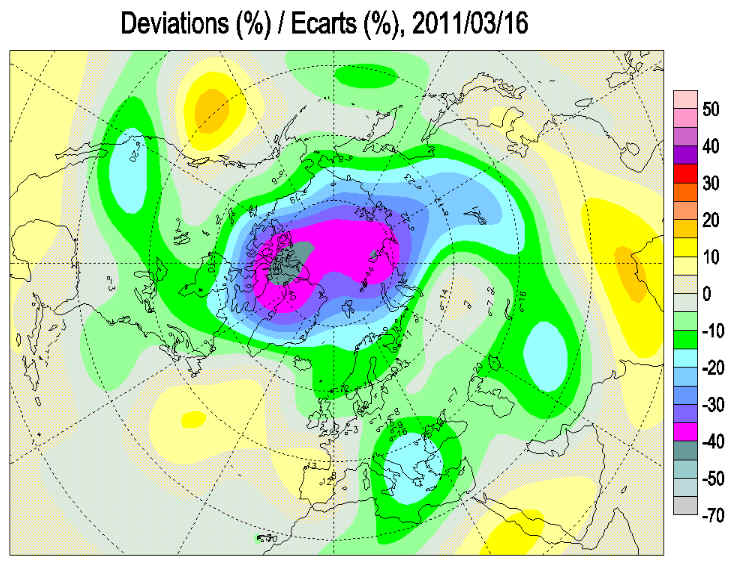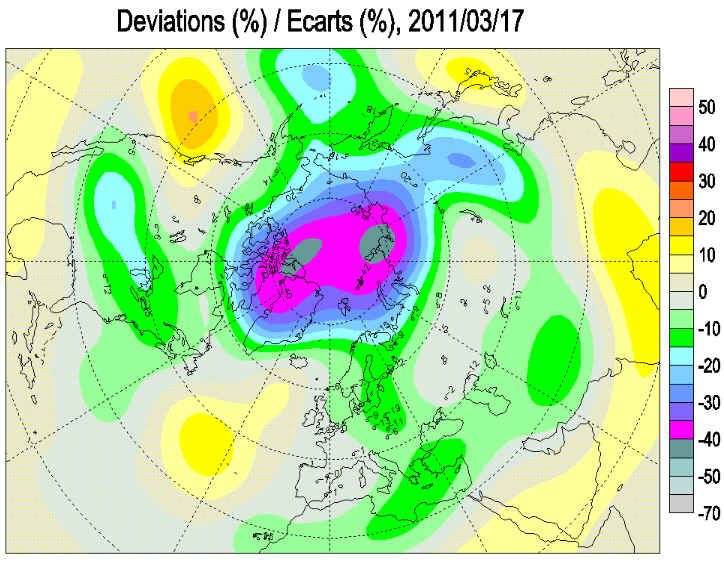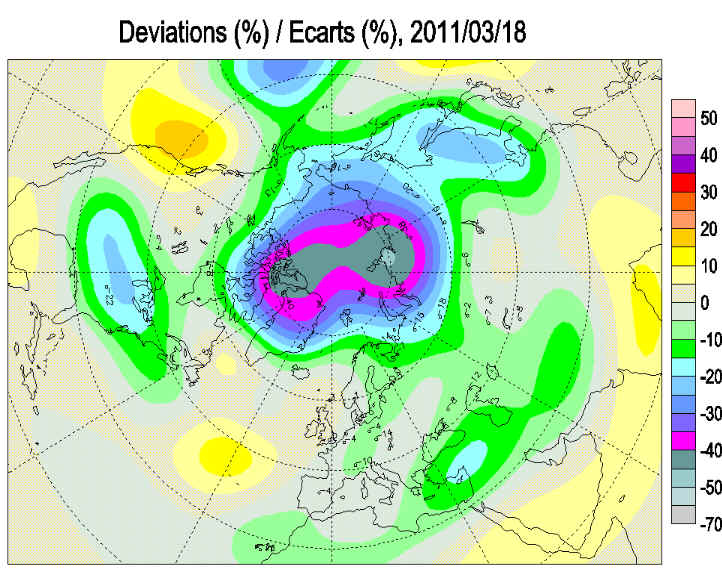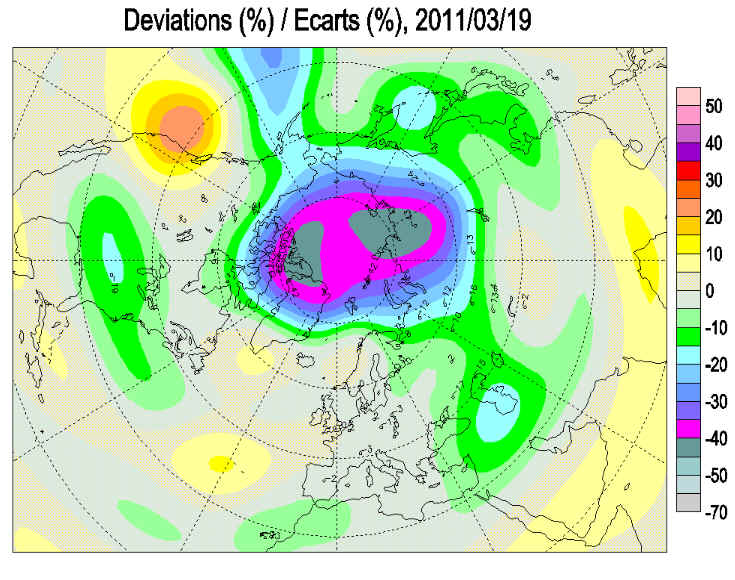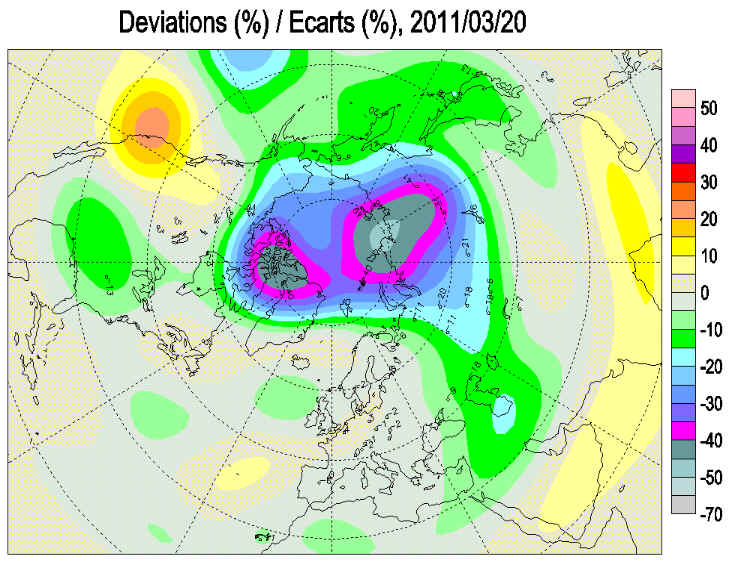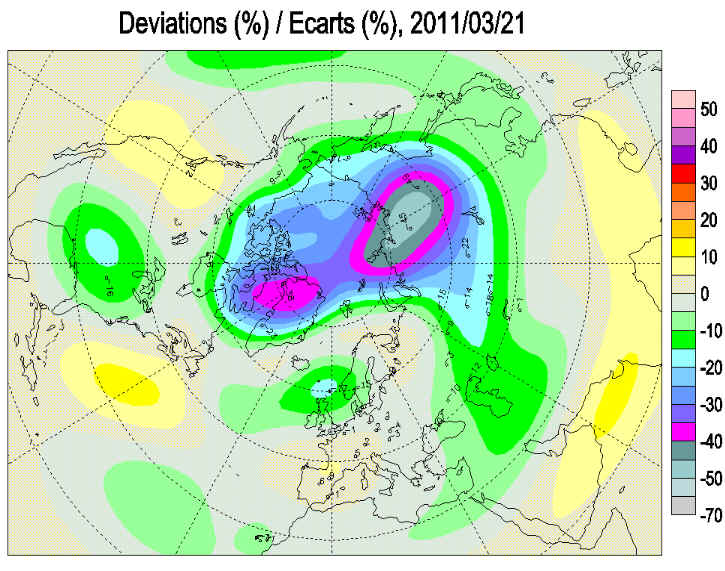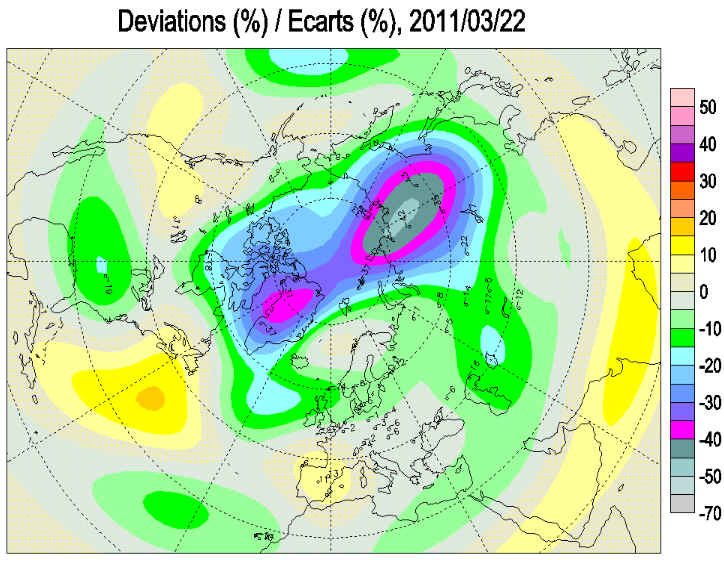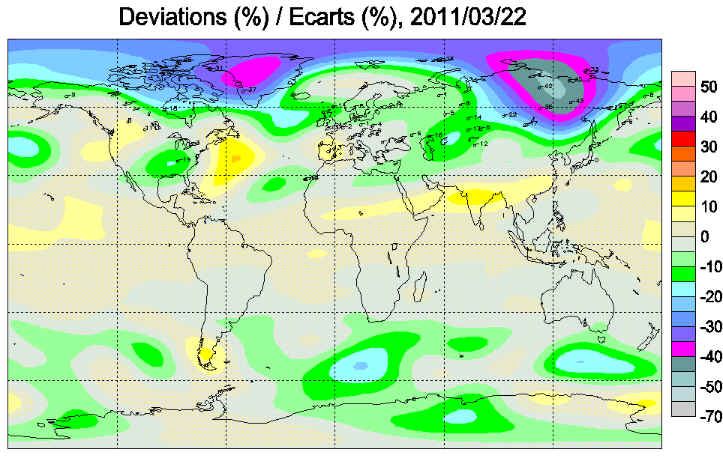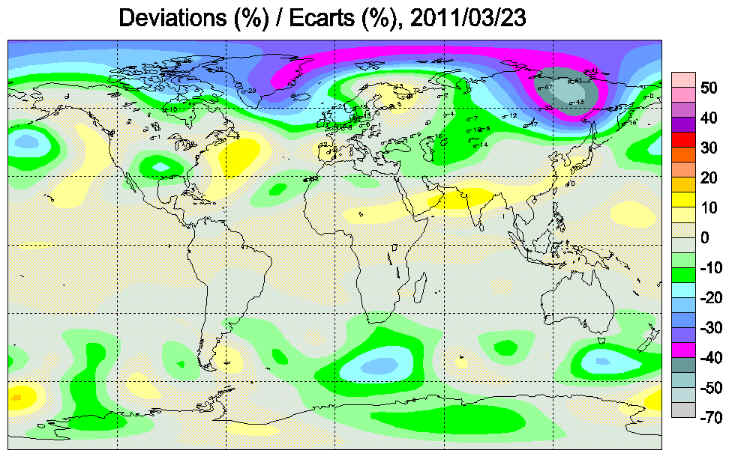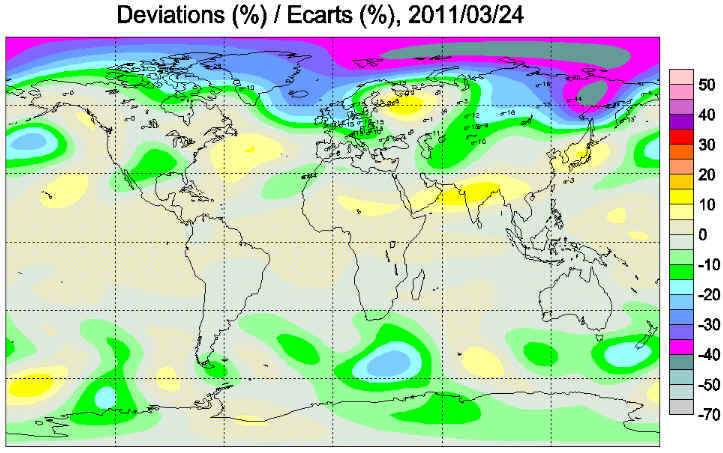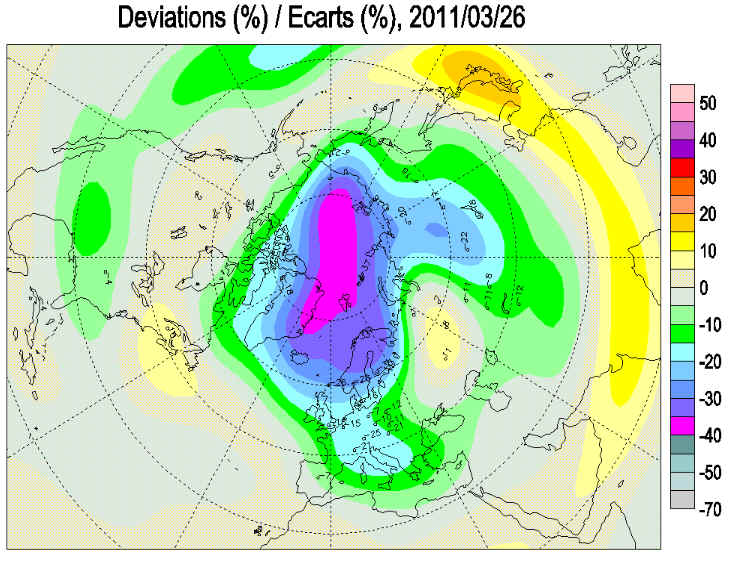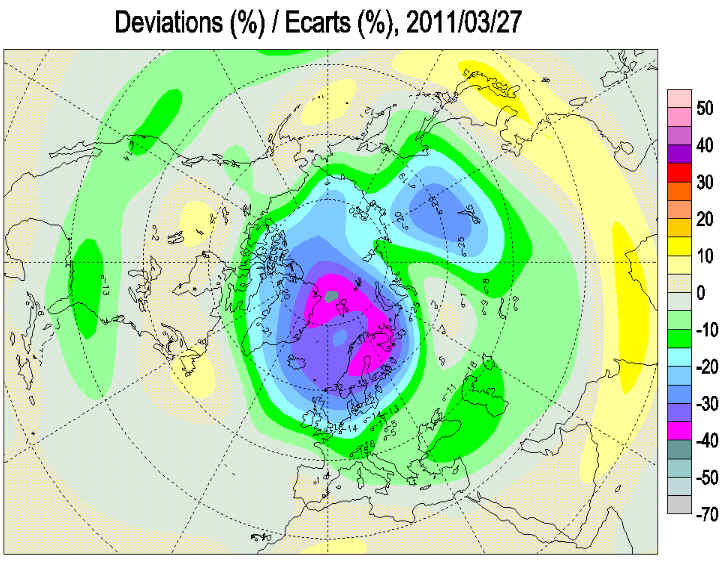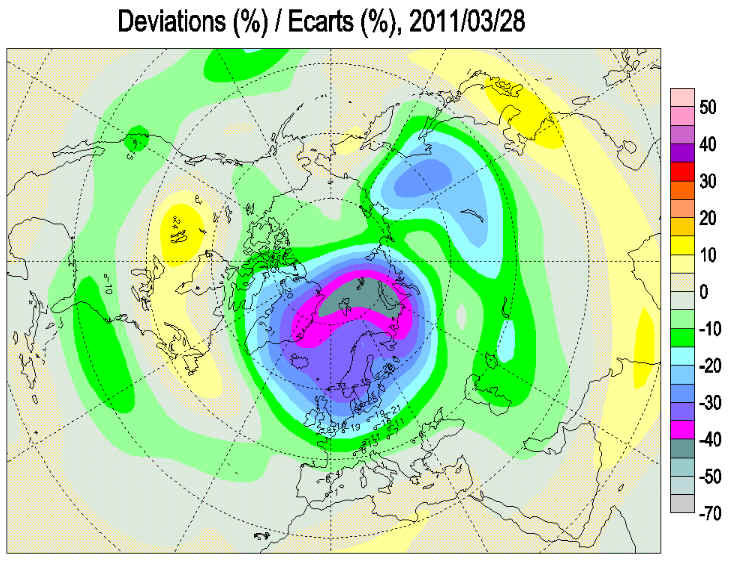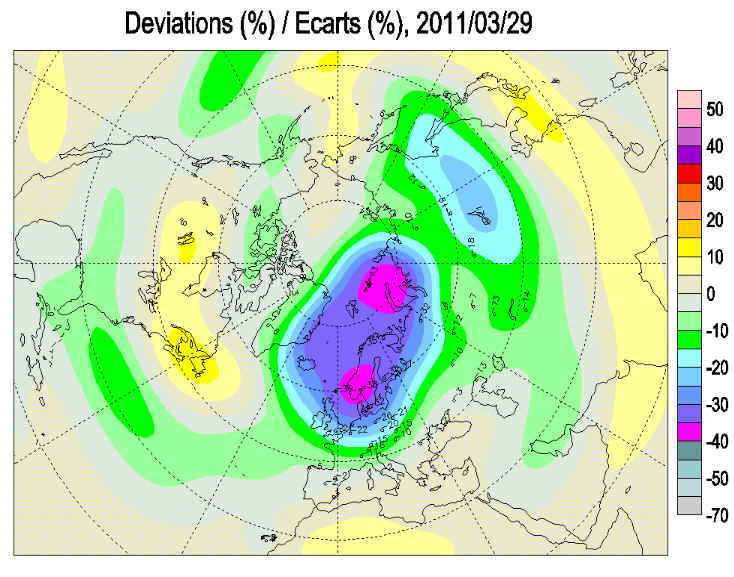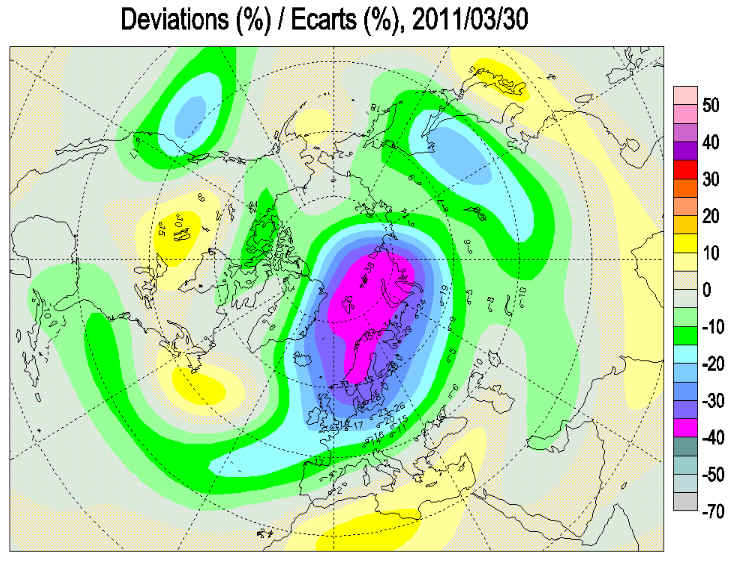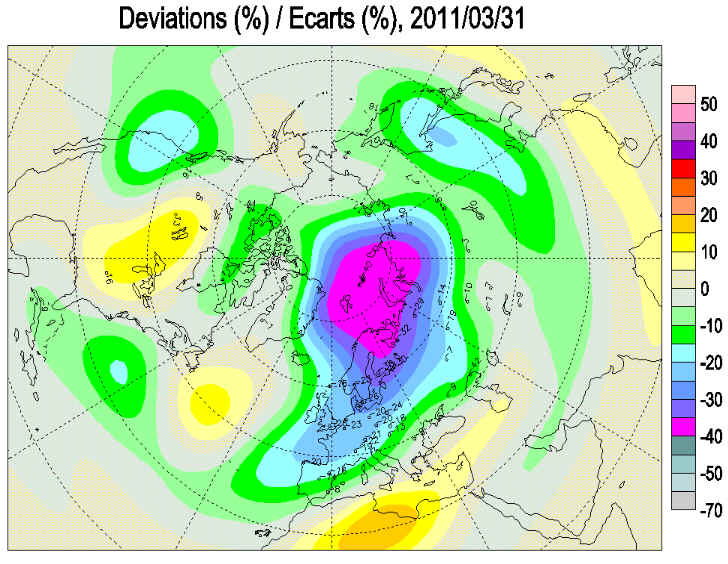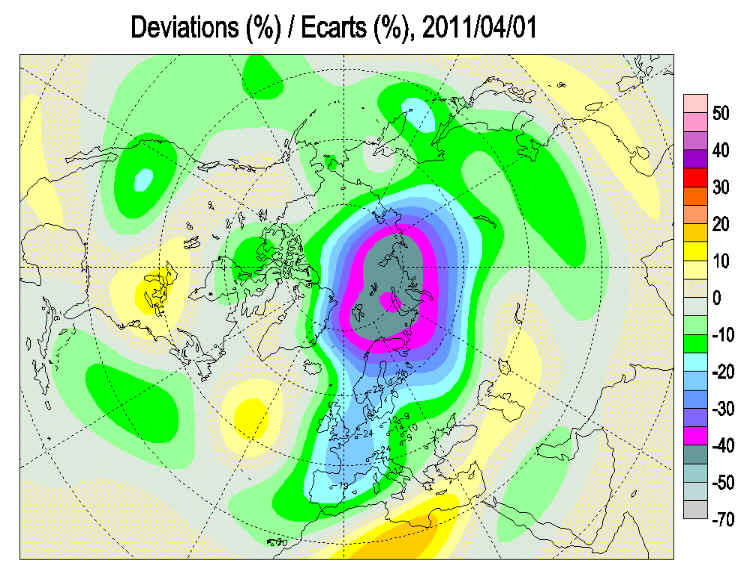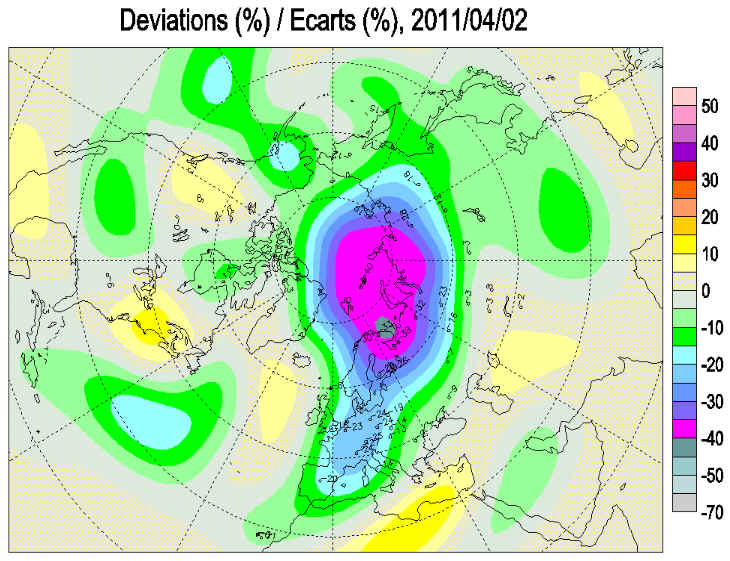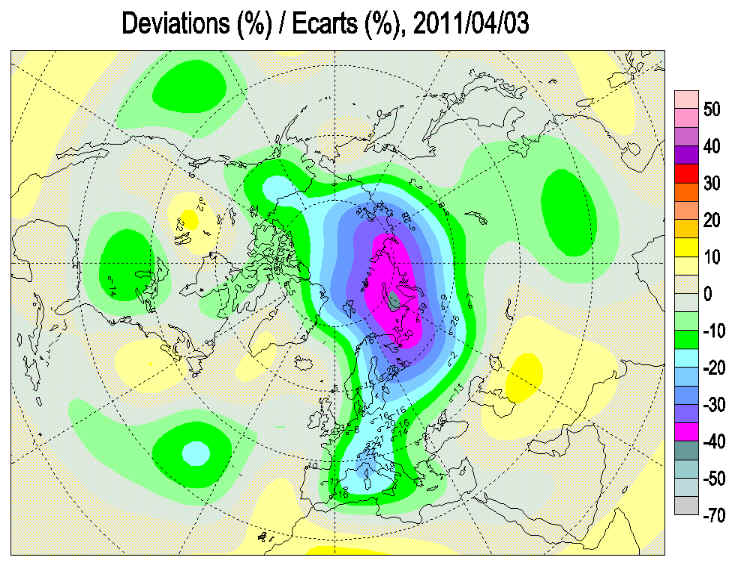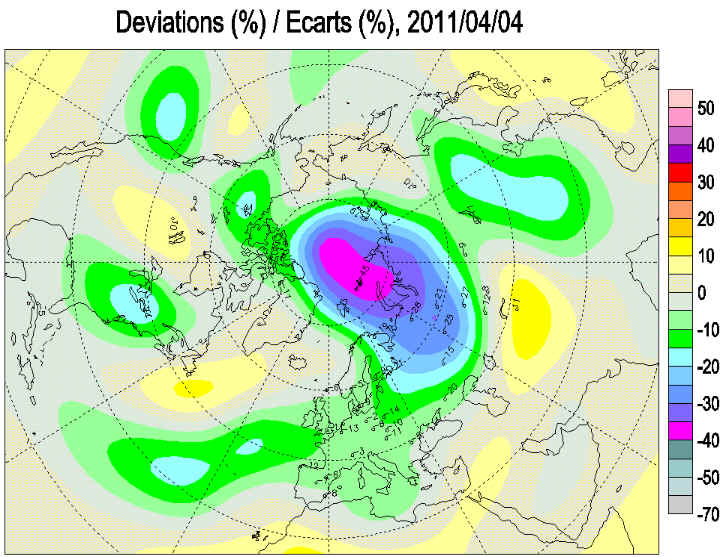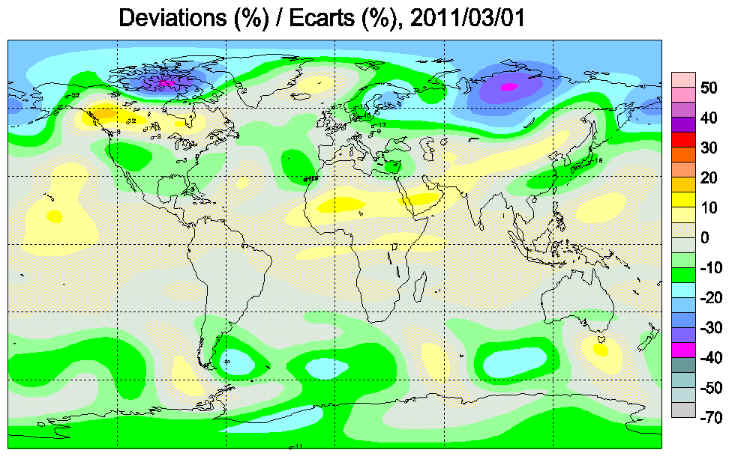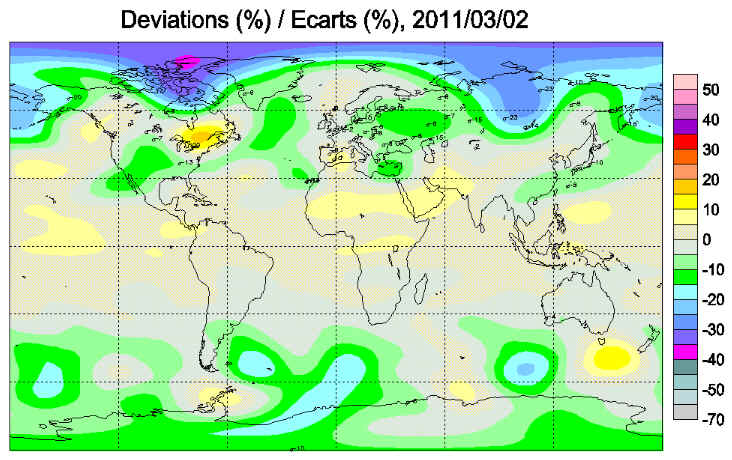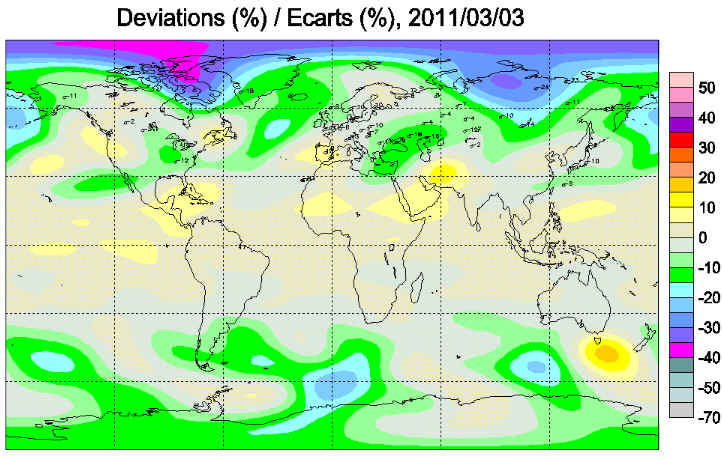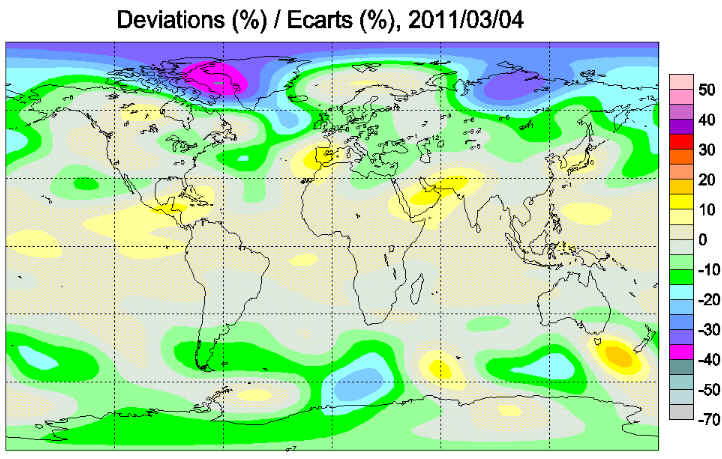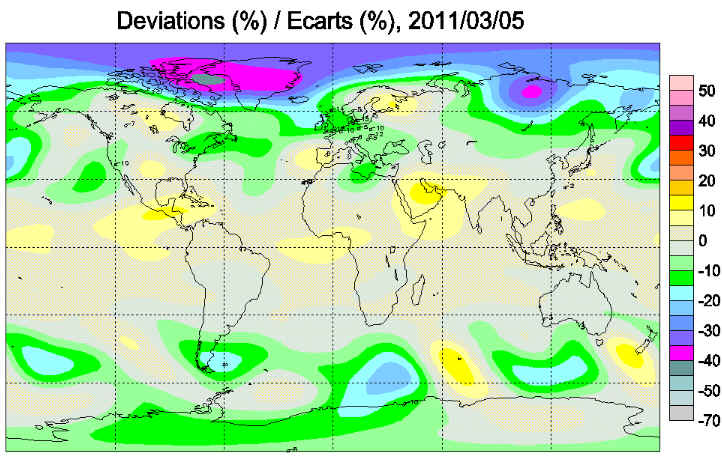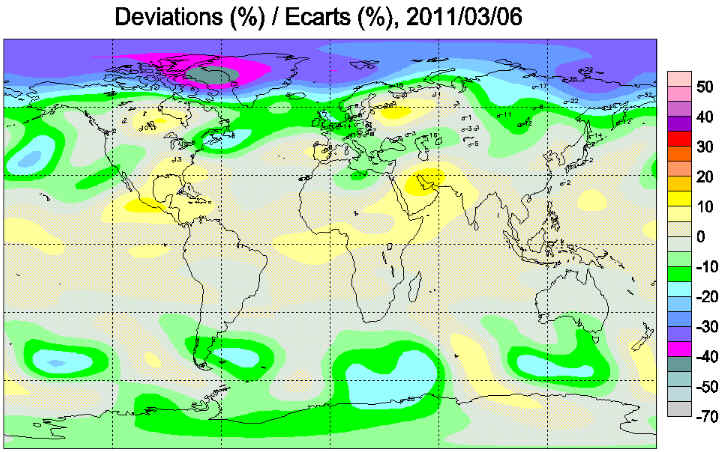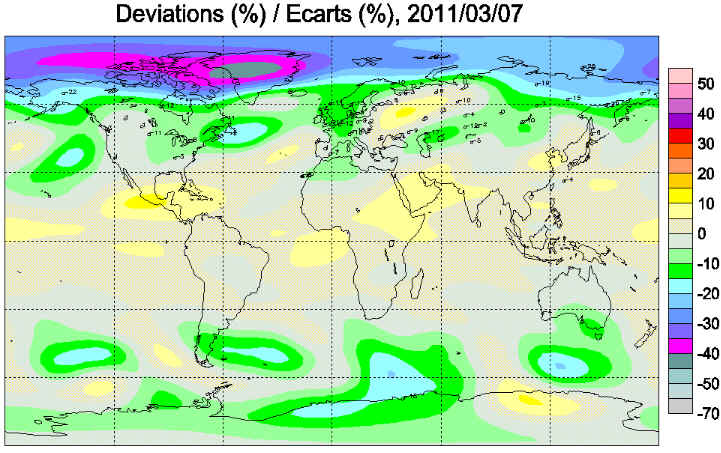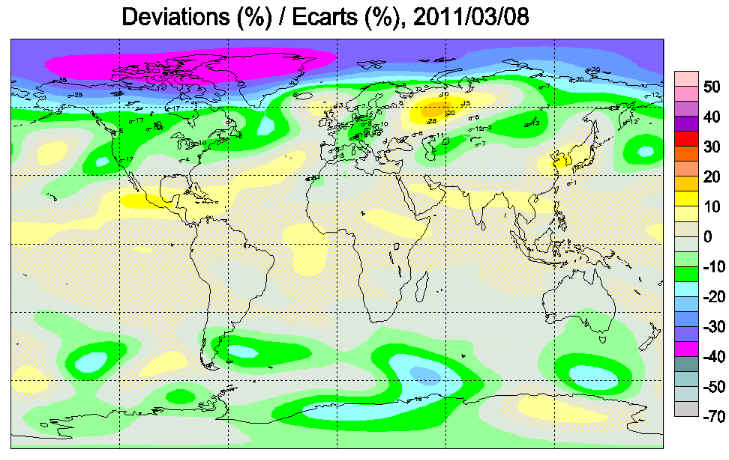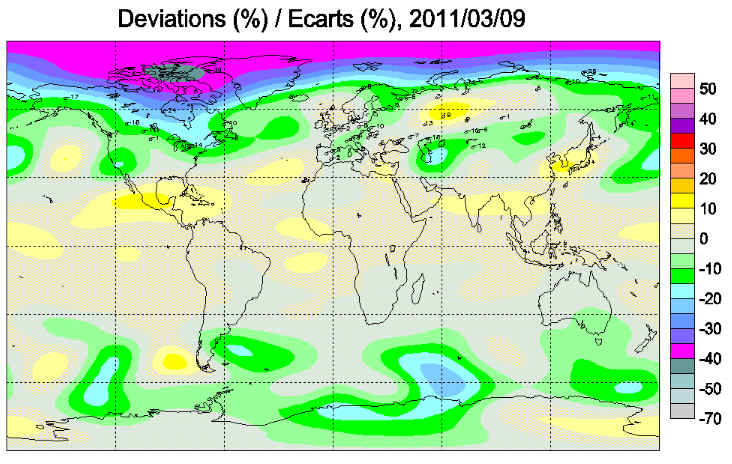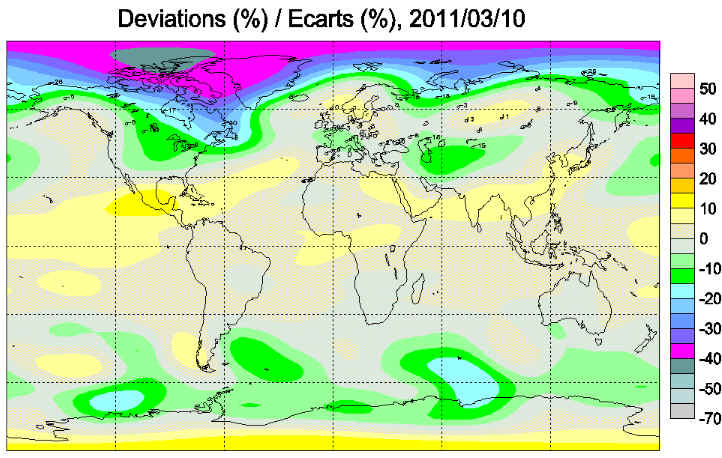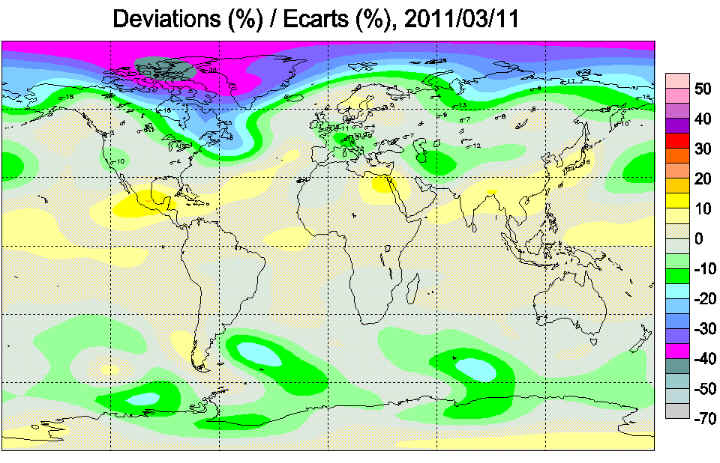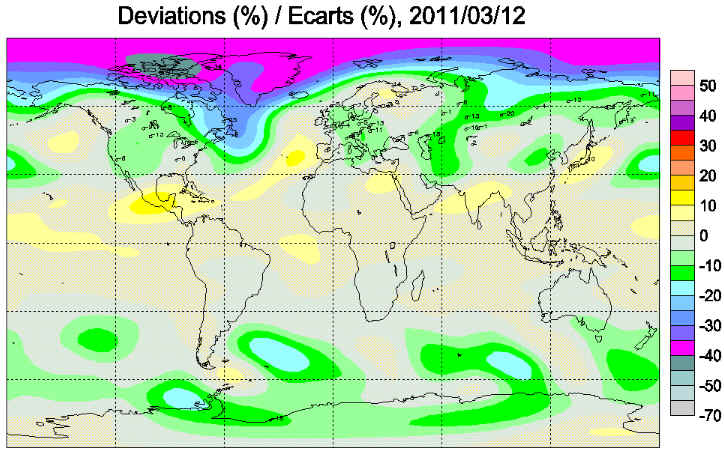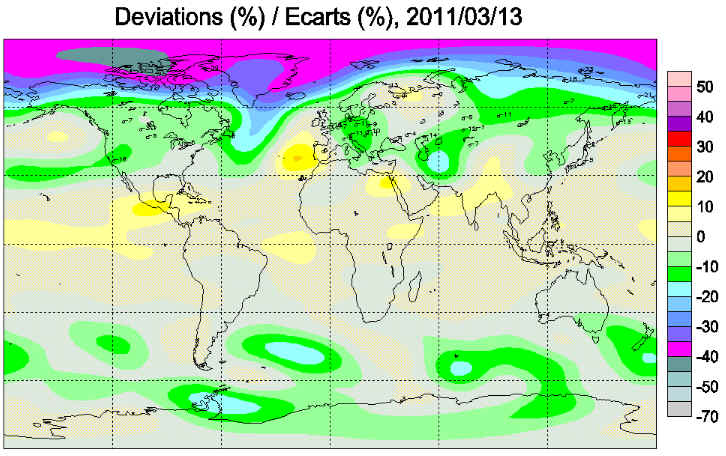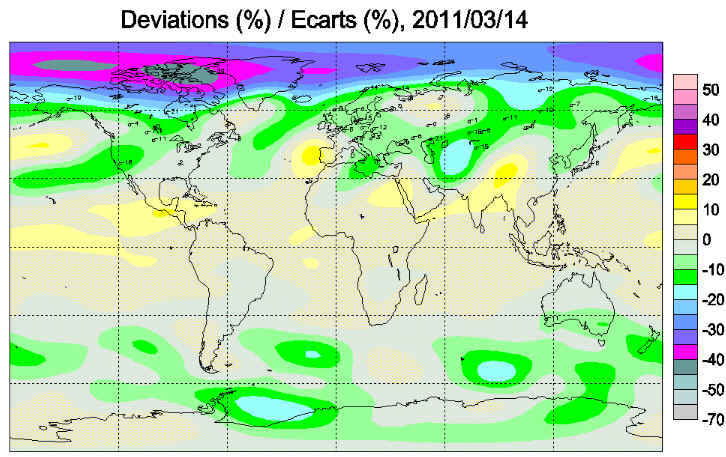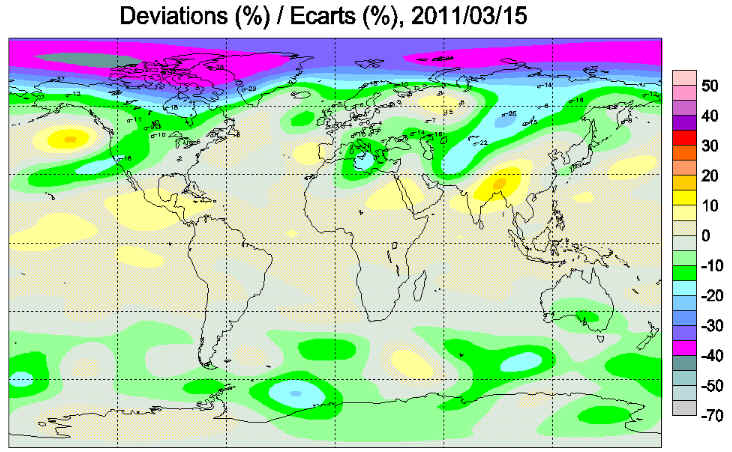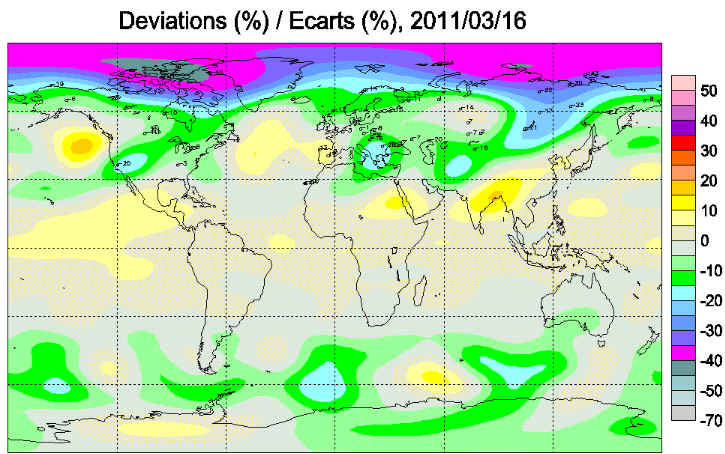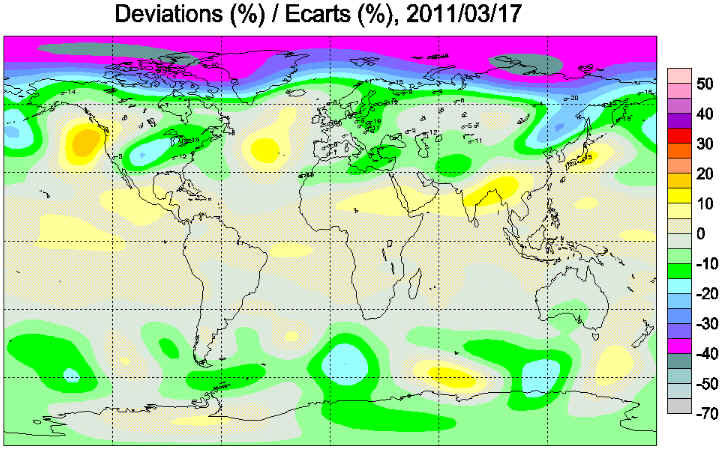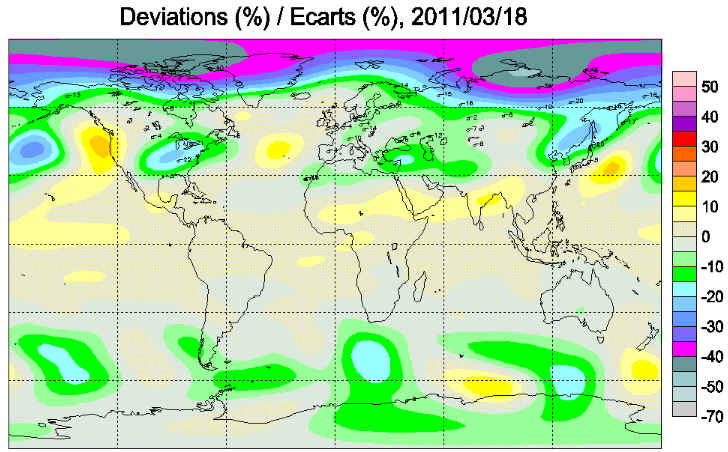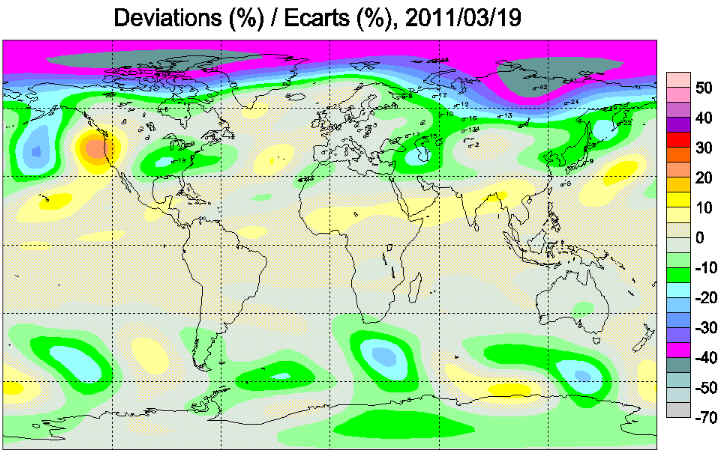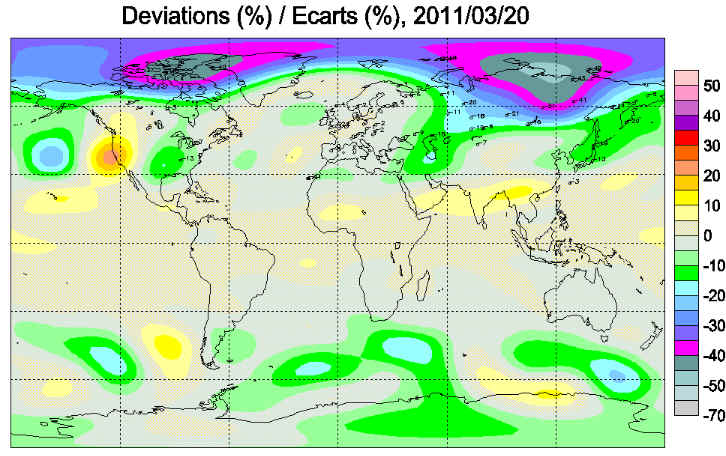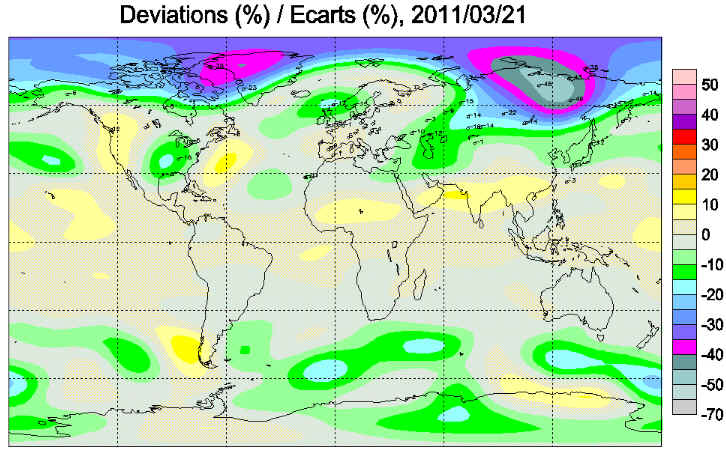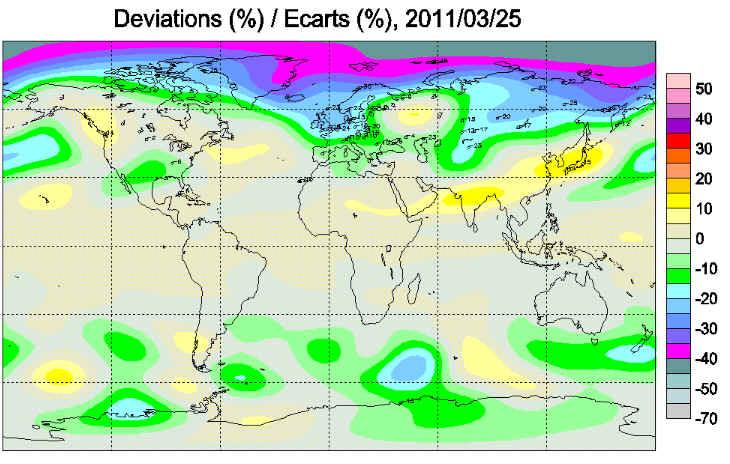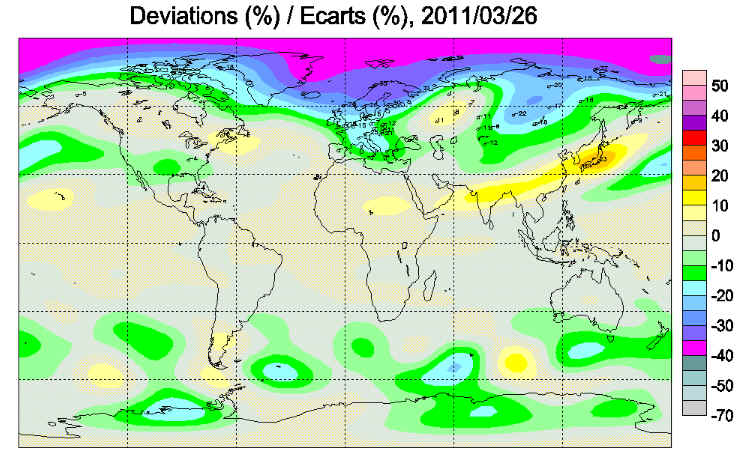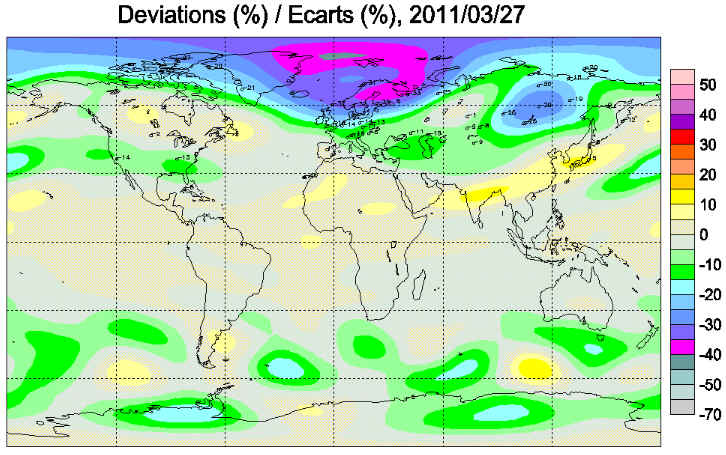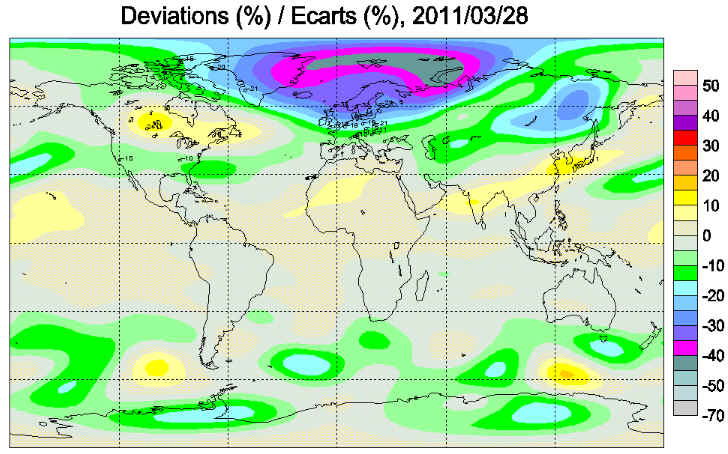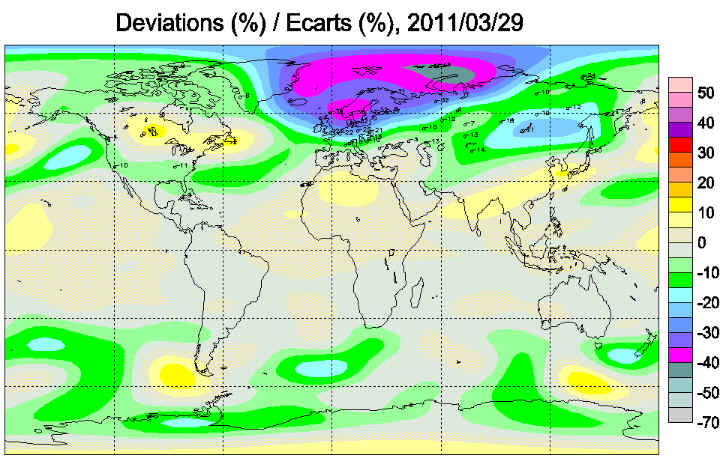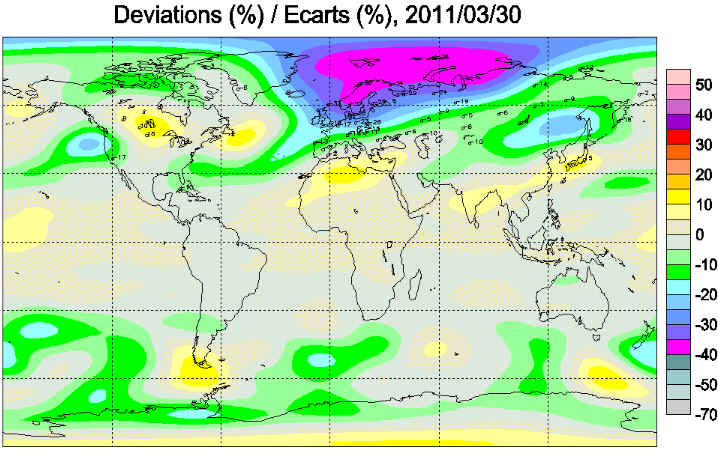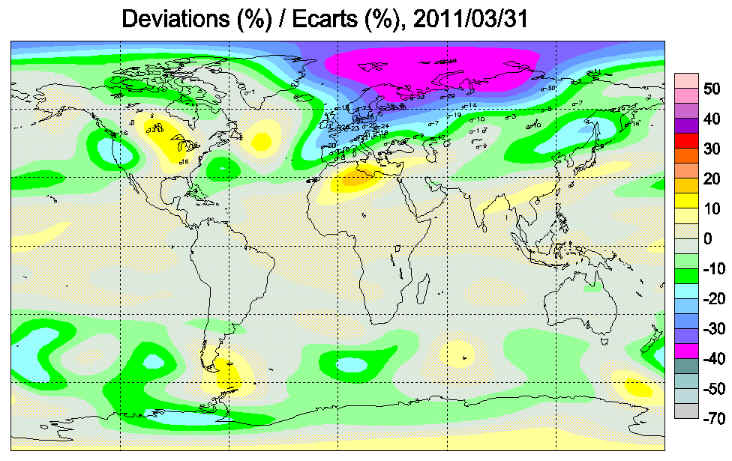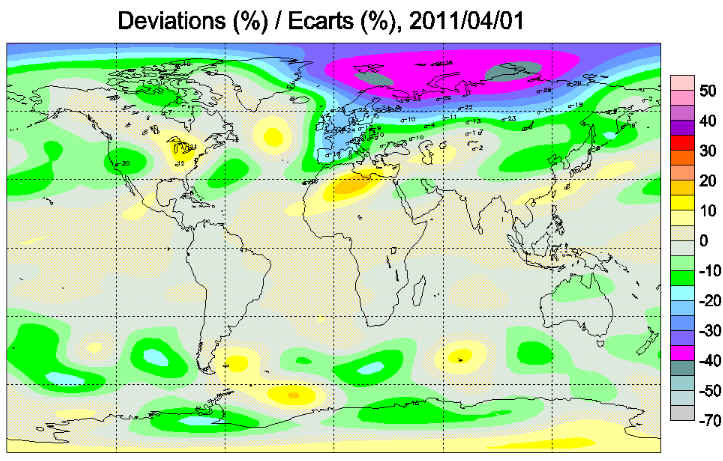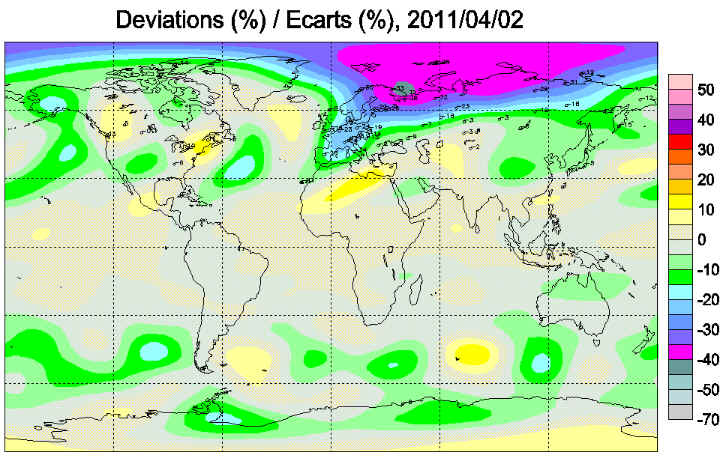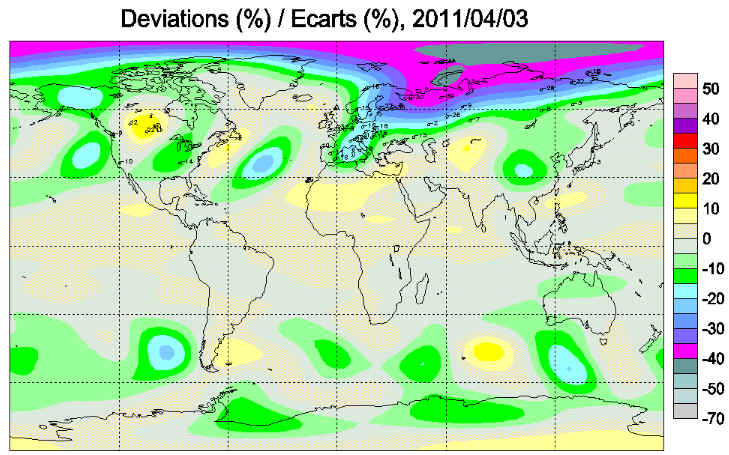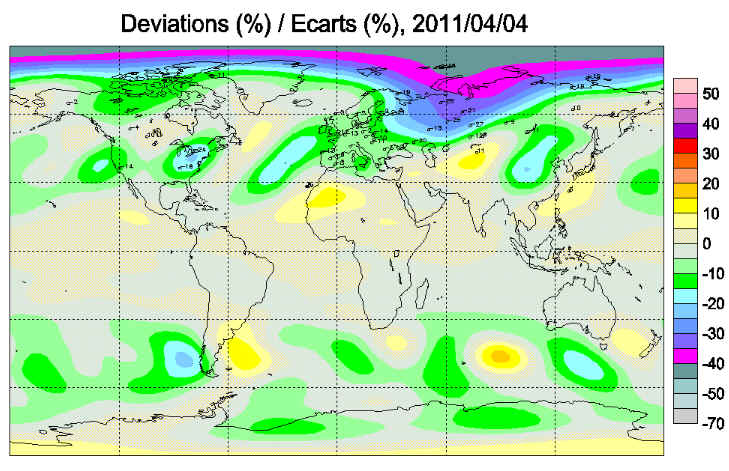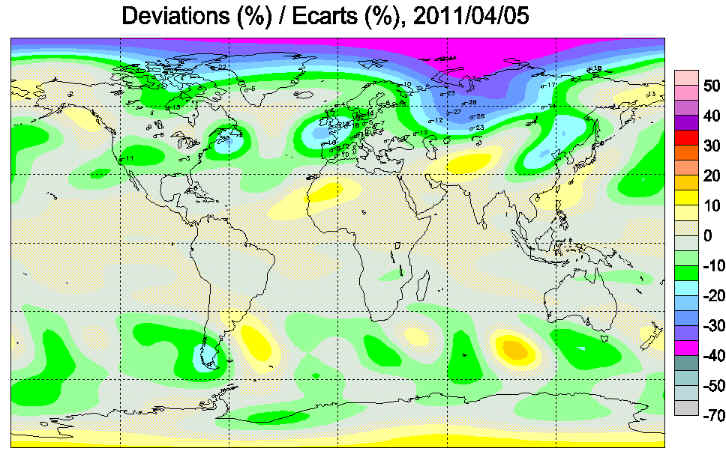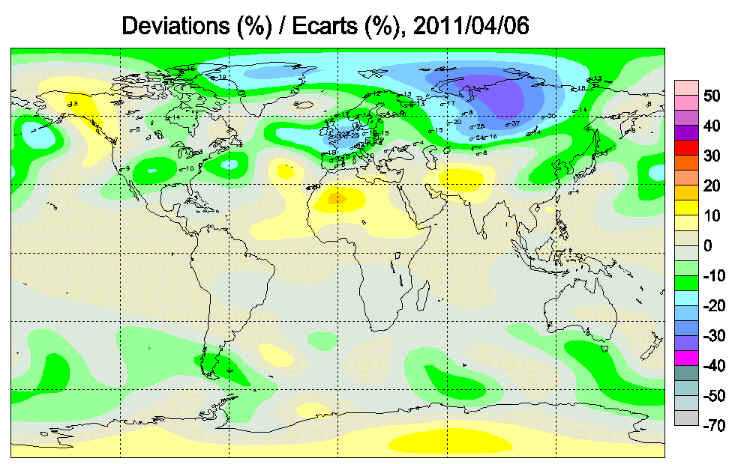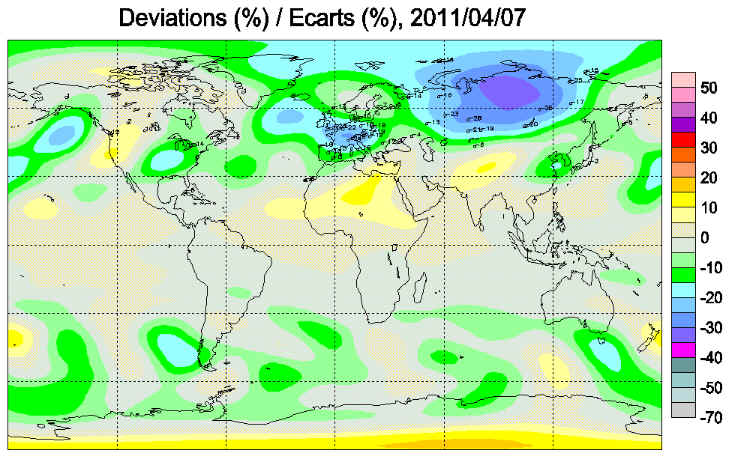|
Record stratospheric ozone loss in the arctic in spring of 2011
Record stratospheric ozone loss in the arctic in spring of 2011 Geneva, 5 April 2011 GENEVA 5 APRIL 2011 (WMO) — Depletion of the ozone layer- the shield that protects life on Earth from harmful levels of ultraviolet rays - has reached an unprecedented level over the Arctic this spring because of the continuing presence of ozone-depleting substances in the atmosphere and a very cold winter in the stratosphere. The stratosphere is the second major layer of the Earth’s atmosphere, just above the troposphere. The record loss is despite an international agreement which has been very successful in cutting production and consumption of ozone destroying chemicals. Because of the long atmospheric lifetimes of these compounds it will take several decades before their concentrations are back down to pre-1980 levels, the target agreed in the Montreal Protocol on Substances that Deplete the Ozone Layer. Observations from the ground and from balloons over the Arctic region as well as from satellites show that the Arctic region has suffered an ozone column loss of about 40% from the beginning of the winter to late March. The highest ozone loss previously recorded was about 30% over the entire winter. In Antarctica the so-called ozone hole is an annually recurring winter/spring phenomenon due to the existence of extremely low temperatures in the stratosphere. In the Arctic the meteorological conditions vary much more from one year to the next and the temperatures are always warmer than over Antarctica. Hence, some Arctic winters experience almost no ozone loss, whereas cold stratospheric temperatures in the Arctic lasting beyond the polar night can occasionally lead to substantial ozone loss. Even though this Arctic winter was warmer than average at ground level, it was colder in the stratosphere than for a normal Arctic winter.
This animation
shows, from 20 February until 4 April, the ozone abundance in the lower
stratosphere where ozone depletion is most intense. The smaller globe shows
values reached in a more common year (2010). One sees that this "ozone hole"
reached Scandinavia at the end of March . Unprecedented but not unexpected Although the degree of Arctic ozone destruction in 2011 is unprecedented, it is not unexpected. Ozone scientists have foreseen that significant Arctic ozone loss is possible in the case of a cold and stable Arctic stratospheric winter. Stratospheric ozone depletion occurs over the polar regions when temperatures drop below -78°C. At such low temperatures clouds form in the stratosphere. Chemical reactions that convert innocuous reservoir gases (e.g. hydrochloric acid) into active ozone depleting gases take place on the clouds particles. The result is rapid destruction of ozone if sunlight is present. Ozone depleting
substances such as chlorofluorocarbons (CFCs) and halons, once present in Without the Montreal Protocol, this year’s ozone destruction would most likely have been worse. The slow recovery of the ozone layer is due to the fact that ozone-depleting substances stay in the atmosphere for several decades. In the polar regions the drop in ozone depleting gases is 10% of what is required to return to the 1980 benchmark level. Global Atmosphere Watch “The Arctic stratosphere continues to be vulnerable to ozone destruction caused by ozone-depleting substances linked to human activities,” said WMO Secretary-General Michel Jarraud. “The degree of ozone loss experienced in any particular winter depends on the meteorological conditions. The 2011 ozone loss shows that we have to remain vigilant and keep a close eye on the situation in the Arctic in the coming years,” he said. “WMO’s Global Atmosphere Watch Network has many stations in the Arctic and helps us to obtain an early warning in case of low ozone and intense UV radiation.” If the ozone depleted area moves away from the pole and towards lower latitudes one can expect increased ultraviolet (UV) radiation as compared to the normal for the season. As the solar elevation at noon increases over the next weeks, regions affected by the ozone depletion will experience higher than normal UV radiation. The public is recommended to stay informed through national UV forecasts. It should be pointed out, however, that the UV radiation will not increase to the same intensity as one suffers in the tropical regions of the globe. The sun is still relatively low in the sky, and this limits the amount of UV radiation that passes through the atmosphere. UV-B rays have been linked to skin cancer, cataracts and damage to the human immune system. Some crops and forms of marine life can also suffer adverse effects. Background The stratosphere is the second major layer of the atmosphere, above the troposphere and below the mesosphere. The stratosphere starts at about 10 km altitude and reaches up to an altitude of about 50 km. About 90% of the ozone in the atmosphere is found the stratosphere with the remaining 10% in the troposphere. The ozone in the stratosphere is called the ozone layer, which absorbs ultraviolet light and protects life on earth from harmful ultraviolet radiation from the sun. The ozone in the troposphere, and especially close to the ground, is unwanted because it is a corrosive gas that causes damage to vegetation and can harm lung function and irritate the respiratory system in humans and animals. Increased amounts of greenhouse gases lead to higher temperatures at the surface of the earth, but models show that the stratosphere at the same time will get colder. Therefore ozone scientists have foreseen that significant ozone loss can happen in the Arctic stratosphere. If the cold temperatures persist into spring, i.e. when the sun comes back after the polar night, ozone destruction speeds up. In Antarctica such conditions prevail every winter/spring season, whereas in the Arctic the variability from one year to the next is much larger. Large ozone loss is therefore not an annually recurring phenomenon in the Arctic stratosphere. While increased amounts of longlived greenhouse gases, such as carbon dioxide and methane, are expected to cause some cooling of the stratosphere in the long term, it cannot explain the large variations in temperature that is observed from one year to the next in the Arctic stratosphere. Both satellite observations and coordinated launches of ozonesondes carried by weather balloons show us at which altitudes the ozone loss takes place. These measurements show that the ozone loss takes place between 15 and 23 km above the ground with an ozone minimum around 19-20 km. This coincides with the region of low temperatures below -78°C. In this region more than 2/3 of the ozone has been destroyed so far. Measurements from the SCIAMACHY satellite instrument show record high amounts of the molecule OClO, a compound that takes part in ozone destruction. Satellite measurements of total ozone from OMI, GOME-2 and SCIAMACHY show a region of low ozone above the Arctic regions. As of late March the ozone poor region is shifted away from the pole and covers Greenland and Scandinavia. The Vienna Convention to Protect the Ozone Layer came into force in 1985. Two years later the Montreal Protocol to phase out production and consumption of ozone-depleting products was signed. The Montreal Protocol has been reinforced on several occasions after 1987.
Images of total ozone column and vertical ozone profiles around the pole on March 30, developed by Finnish Meteorological Institute using satellite and ground based data The 2010 WMO/UNEP Scientific Assessment on Ozone Depletion is available at http://www.esrl.noaa.gov/csd/assessments/ozone/ with more details about the current state of the ozone layer and projections for the future. For more information, please contact: Carine Richard-Van Maele, Chief, Communications and Public Affairs, Tel: +(41 22) 730 8315; +(41 79) 406 47 30 (cell); e-mail: cpa[at]wmo.int Clare Nullis, Press Officer,
Communications and Public Affairs, Tel: +(41 22) 730 8478; 14 March 2011: Arctic on the verge of record ozone loss - Arctic-wide measurements verify rapid depletion in recent daysPotsdam/Bremerhaven, March 14th, 2011. Unusually low temperatures in the Arctic ozone layer have recently initiated massive ozone depletion. The Arctic appears to be heading for a record loss of this trace gas that protects the Earth’s surface against ultraviolet radiation from the sun. This result has been found by measurements carried out by an international network of over 30 ozone sounding stations spread all over the Arctic and Subarctic and coordinated by the Potsdam Research Unit of the Alfred Wegener Institute for Polar and Marine Research in the Helmholtz Association (AWI) in Germany.
“Our measurements show that at the relevant altitudes about half of the ozone that was present above the Arctic has been destroyed over the past weeks,” says AWI researcher Markus Rex, describing the current situation. “Since the conditions leading to this unusually rapid ozone depletion continue to prevail, we expect further depletion to occur.” The changes observed at present may also have an impact outside the thinly populated Arctic. Air masses exposed to ozone loss above the Arctic tend to drift southwards later. Hence, due to reduced UV protection by the severely thinned ozone layer, episodes of high UV intensity may also occur in middle latitudes. “Special attention should thus be devoted to sufficient UV protection in spring this year,” recommends Rex.
Ozone is lost when breakdown products of anthropogenic chlorofluorocarbons (CFCs) are turned into aggressive, ozone destroying substances during exposure to extremely cold conditions. For several years now scientists have pointed to a connection between ozone loss and climate change, and particularly to the fact that in the Arctic stratosphere at about 20km altitude, where the ozone layer is, the coldest winters seem to have been getting colder and leading to larger ozone losses. “The current winter is a continuation of this development, which may indeed be connected to global warming,” atmosphere researcher Rex explains the connection that appears paradoxical only at first glance. “To put it in a simplified manner, increasing greenhouse gas concentrations retain the Earth’s thermal radiation at lower layers of the atmosphere, thus heating up these layers. Less of the heat radiation reaches the stratosphere, intensifying the cooling effect there.” This cooling takes place in the ozone layer and can contribute to larger ozone depletion. “However, the complicated details of the interactions between the ozone layer and climate change haven’t been completely understood yet and are the subject of current research projects,” states Rex. The European Union finances this work in the RECONCILE project, a research programme supported with 3.5 million euros in which 16 research institutions from eight European countries are working towards improved understanding of the Arctic ozone layer.
In the long term the ozone layer will recover thanks to extensive environmental policy measures enacted for its protection. This winter’s likely record-breaking ozone loss does not alter this expectation. “By virtue of the long-term effect of the Montreal Protocol, significant ozone destruction will no longer occur during the second half of this century,” explains Rex. The Montreal Protocol is an international treaty adopted under the UN umbrella in 1987 to protect the ozone layer and for all practical purposes bans the production of ozone-depleting chlorofluorocarbons (CFCs) worldwide today. CFCs released during prior decades however, will not vanish from the atmosphere until many decades from now. Until that time the fate of the Arctic ozone layer essentially depends on the temperature in the stratosphere at an altitude of around 20 km and is thus linked to the development of earth’s climate. Notes for Editors: Contacts at Alfred Wegener Institute Your contact at the Potsdam Research Unit of the Alfred Wegener Institute is Dr Markus Rex (tel.: +49 (0)174 311 8070, +49 (0)331 288 2127; e-mail: Markus.Rex(at)awi.de). Your contact in the Communications and Media Department is Ralf Röchert (tel: +49 (0)471 4831-1680; e-mail: Ralf.Roechert@awi.de). The Alfred
Wegener Institute conducts research in the Arctic, Antarctic and oceans of the
high and middle latitudes. It coordinates polar research in Germany and provides
major infrastructure to the international scientific community, such as the
research icebreaker Polarstern and stations in the Arctic and Antarctica. The
Alfred Wegener Institute is one of the seventeen research centres of the
Helmholtz Association, the largest scientific organisation in Germany. Belgium Maps of deviations represent total ozone deviations from the 1978-1988 level estimated using Total Ozone Mapping Spectrometer (TOMS) data for all areas except the Antarctic and from the pre-1980 level estimated using Dobson data over the Antarctic. Over areas with poor data coverage adjustments are made according to TOMS on Nimbus-7, Meteor-3, ADEOS and Earth Probe satellites. Over the polar night area Dobson and Brewer moon observations and/or NOAA's TIROS Operational Vertical Sounder (TOVS) satellite data are used. TOVS data are also used when the more reliable TOMS data are not available. The mapping algorithm is similar to those used by the WMO Ozone Mapping Centre.
|



